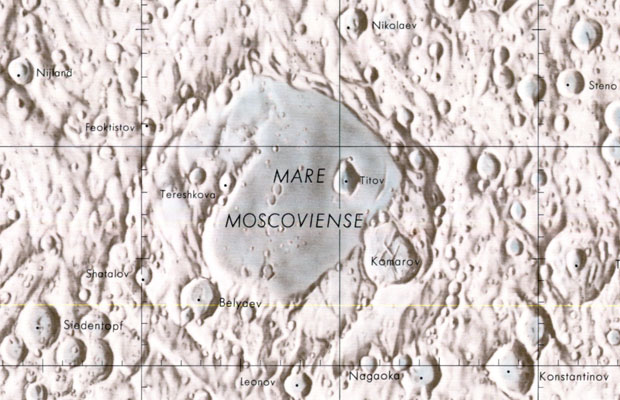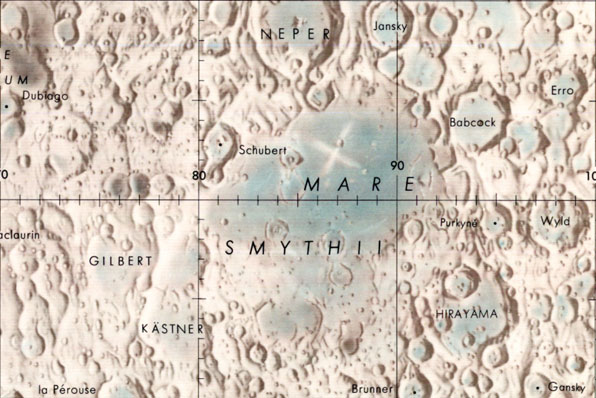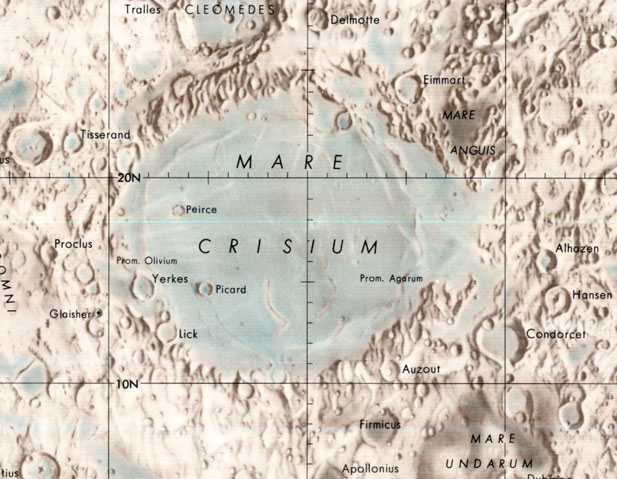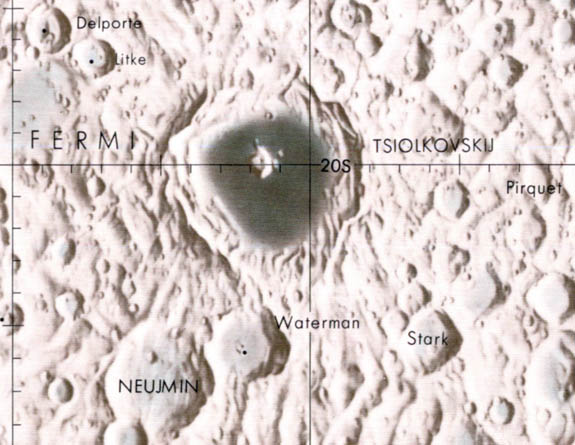Apollo 13
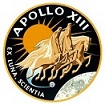
Day 4, part 2: Leaving the Moon
Corrected Transcript and Commentary Copyright ©2020 by W. David Woods, Johannes Kemppanen, Frank O'Brien, Alexander Turhanov and Lennox J. Waugh. All rights reserved.
Last updated 2020-04-27
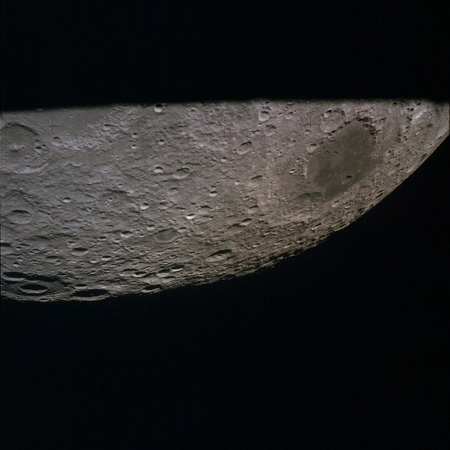
Photograph AS13-62-8923, showing Mare Moscoviense.
Apollo Control, Houston. We're two minutes now from time of reacquiring Apollo 13. Meanwhile, we have an update in the impact of the third stage of the Saturn, the S-IVB. Our latest estimate indicates impact at 77 hours, 56 minutes, 27 seconds Ground Elapsed Time. The predicted coordinate for impact: 26 degrees, 57 minutes south longitude; latitude, 28 degrees, 27 minutes west. Coming up now on one minute to AOS. We'll stand by and continue to monitor. This is Apollo Control, Houston.
Standing by now for acquisition.
077:33:50 Lovell: Good morning, Houston. How do you read? [Long pause.]
077:34:06 Haise: [Garble]. [Long pause.]
077:34:37 Brand: Aquarius, Houston. Over.
077:34:41 Lovell: Stand by for AOS. [Long pause.]
077:35:02 Lovell: Houston, how do you read Aquarius?
077:35:05 Brand: Aquarius, Houston. Reading you about 3 by 3. [Long pause.]
077:35:43 Haise: Houston, Aquarius. How do you read?
077:35:49 Brand: Okay, Fred. Reading you fairly well now. How do you read?
077:35:53 Haise: Okay. I read you loud and clear, [garble].
077:38:34 Haise: Jack, why don't you get the other [garble]? [Long pause.]
This is Apollo Control, Houston; 77 hours, 38 minutes into the flight. Apollo 13 has now rounded the corner, headed back towards Earth. We show a velocity of 7,062 feet per second [2,152 m/s] and a distance from the Moon of 566 nautical miles [1,048 km].
077:39:23 Lovell: Well, go this way. [Pause.]
077:39:31 Lovell: All right. We're going up on Mare Smythii, now.
77 hours, 40 minutes now into the flight. We show Apollo 13 at 630 nautical miles [1,167 km] away from the Moon. Our ignition clock shows 1 hour, 47 minutes time remaining until start of the Descent Propulsion System burn.
077:40:55 Lovell: We'll see where [garble] zooming off. [Pause.]
077:41:02 Lovell: Oh, yes, yes, we're no longer 139 miles. We're leaving.
077:41:08 Haise: Yes, look at that curvature. [Pause.]
077:41:18 Lovell: That might be Crisium over there, Fred. [Long pause.]
077:41:37 Haise: Oh, yes; way off on the horizon, there, yes.
077:41:44 Lovell: Hey, if you want to use the 250? There's a beautiful shot of Tsiolkovsky which we very seldom have. [Pause.]
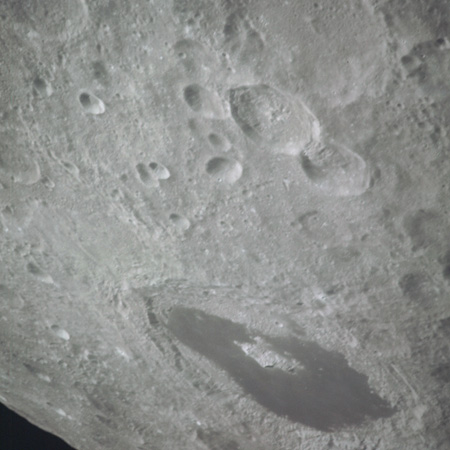
AS13-60-8637 - Crater Tsiolkovsky. Image credit: Image Science and Analysis Laboratory, NASA-Johnson Space Center.
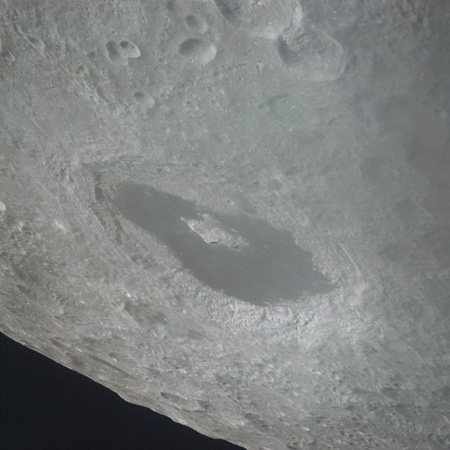
AS13-60-8638 - Crater Tsiolkovsky. Image credit: Image Science and Analysis Laboratory, NASA-Johnson Space Center.
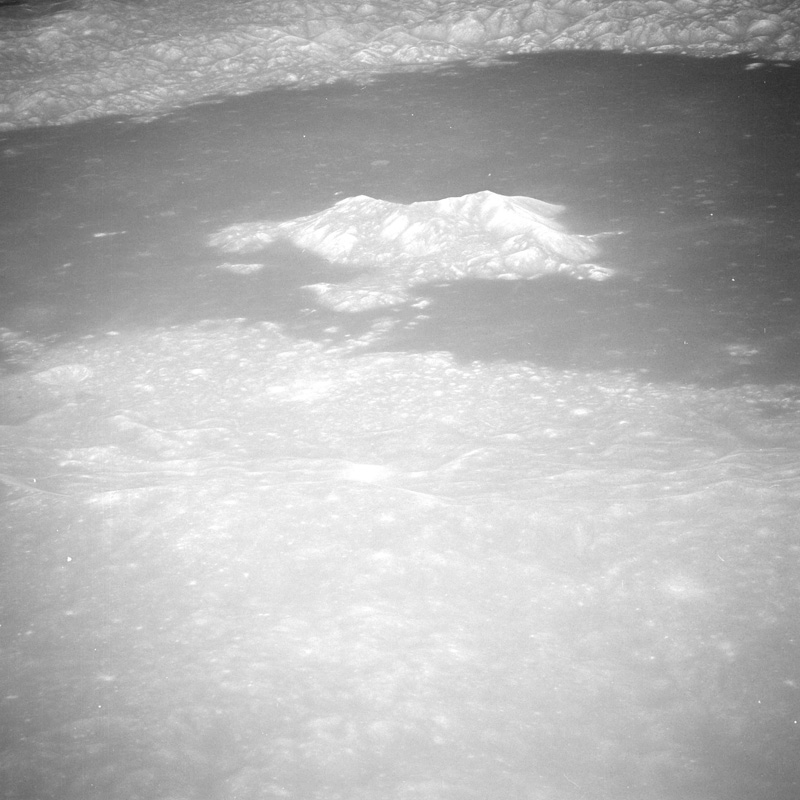
AS08-13-2252 - Apollo 8 image of Tsiolkovsky. Image credit: Image Science and Analysis Laboratory, NASA-Johnson Space Center.
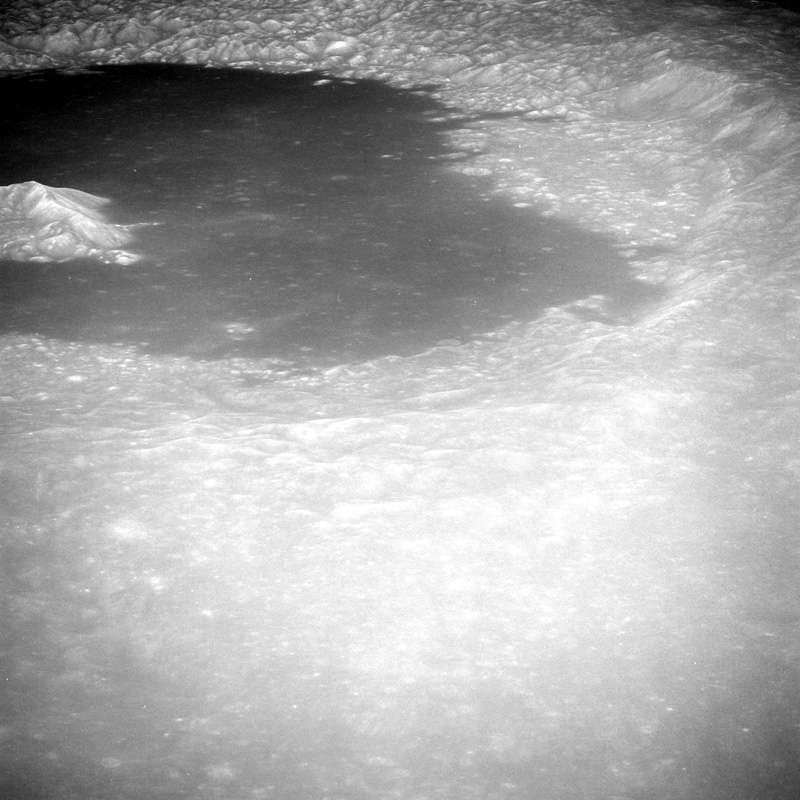
AS08-13-2253 - Apollo 8 image of Tsiolkovsky. Image credit: Image Science and Analysis Laboratory, NASA-Johnson Space Center.
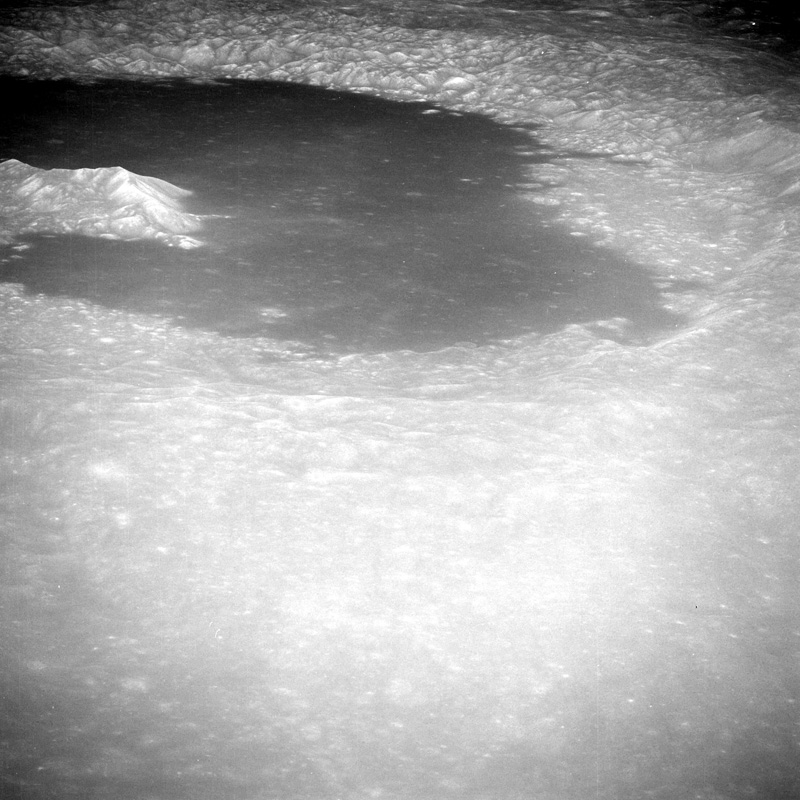
AS08-13-2254 - Apollo 8 image of Tsiolkovsky. Image credit: Image Science and Analysis Laboratory, NASA-Johnson Space Center.
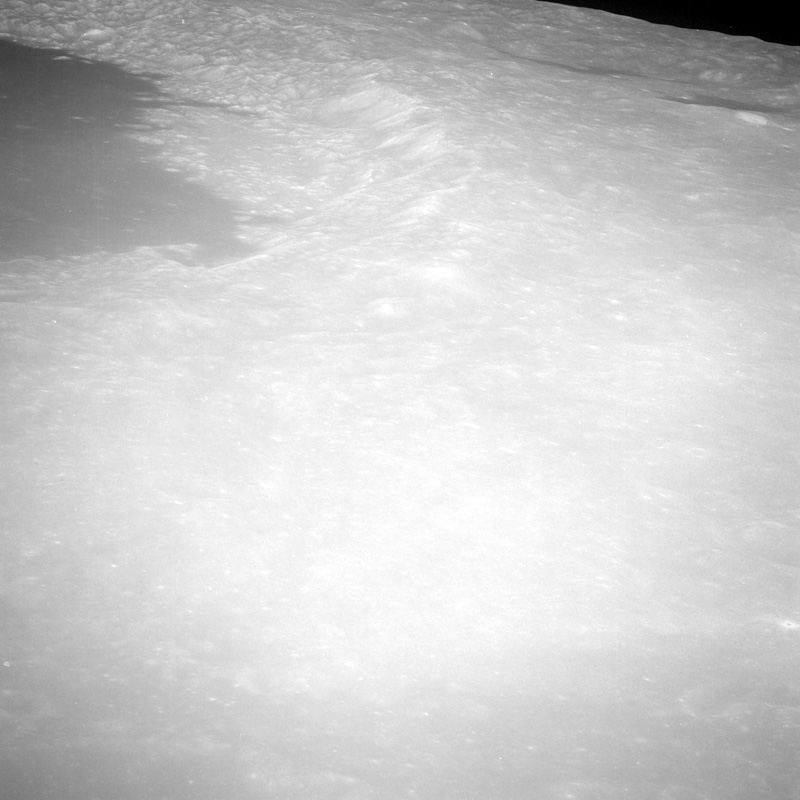
AS08-13-2255 - Apollo 8 image of Tsiolkovsky. Image credit: Image Science and Analysis Laboratory, NASA-Johnson Space Center.
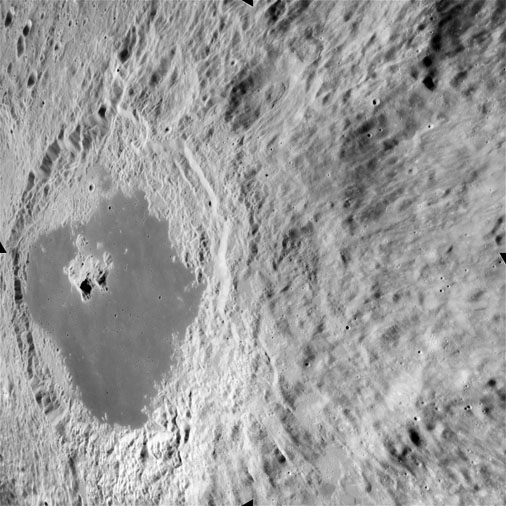
AS15-M-0757 - An oblique image of Tsiolkovsky taken by the metric camera on Apollo 15. Clicking on the image leads to an intermediate size image version of 16 megapixels resolution. A
very large version of 262 megapixels resolution and a file size of 47.7 MB is also available. Image credit: NASA/JSC/ASU.
077:42:04 Lovell: Well, at this stage of the game beggars can't be choosers, I guess.
077:42:08 Swigert: Yes, and we can't afford the amps to use the heaters. [Long pause.]
077:42:36 Lovell: Here you go. [Long pause.]
077:43:33 Lovell: All right. You're in zero phase up here. [Pause.]
077:43:46 Lovell: Are we - back to Down Voice Backup?
077:43:48 Swigert: What's that?
077:43:49 Lovell: We Down Voice Backup?
077:43:51 Lovell: Houston, Aquarius.
077:43:55 Brand: Go ahead, Aquarius.
077:44:01 Lovell: Roger. We still want an activation start time for a burn.
077:44:07 Brand: Understand. You want a power-up time, is that affirm?
077:44:14 Lovell: That's affirm. [Pause.]
077:44:21 Brand: Okay. Stand by. [Long pause.]
077:44:48 Lovell: Okay. Look it. Let's get the cameras squared away; let's get all set to burn. We got one chance now.
077:44:56 Lovell: We're not going to hack it at 152 hours.
077:45:02 Brand: Aquarius, Houston. Over.
077:45:08 Lovell: Go ahead, Houston.
077:45:10 Brand: Jim, regarding the start time for the power-up, you mentioned an hour and 15 minutes. We think that is adequate. This is crew preference depending on how much time you think you need. We would go along with an hour and 15 minutes...
077:45:46 Lovell: Okay - Okay, sounds good.
That's the power-up activation time for the Descent Propulsion System engine burn. We're now at 77 hours, 46 minutes into the flight of Apollo 13. Apollo 13 now 872 nautical miles [1,615 km] away from the Moon. Meanwhile in Mission Control Center, one of our special purpose clocks is counting down to the predicted time of S-IVB impact. We show 10 minutes, 30 seconds remaining.
077:47:24 Lovell: Okay, Freddo. You been through most of that checklist for an hour? Let's get it out and [garble]. [Long pause.]
077:47:50 Haise: 78 hours and [garble].
077:47:56 Lovell: Okay. Let's [garble].
077:48:09 Haise: Hey, Jack. Did you [garble] camera back up [garble]?
077:48:18 Haise: Okay. Page 1.
077:48:22 Haise: Page 2, I'm going to power up the [garble].
Apollo Control, Houston; at 77 hours, 49 minutes now into the mission. We presently show Apollo 13 at 1,007 nautical miles [1,865 km] away from the Moon, its velocity slowing down now relative to the Moon. Now reading 6,399 feet per second [1,950 m/s].
Apollo Control, Houston; 77 hours, 52 minutes now into the flight. We show five minutes away now from time of the predicted impact of the S-IVB.
077:52:38 Brand: Aquarius, Houston. Over.
077:52:43 Lovell: Go ahead, Houston.
077:52:46 Brand: Okay, Jim. We have about three items for you. We have a maneuver PAD, P30 LM maneuver, again; and the maneuver PAD for the CM for splashdown. We also have a checklist change with contingencies, - LM contingencies checklist. And, I'll stand by while you're gathering the books.
077:53:15 Haise: Okay. I'm at - I got the contingency book, so give me that one first.
077:53:20 Brand: Okay. Page 18 [garble].
077:53:26 Haise: Okay. I'm at page 18.
077:53:28 Brand: Okay. About half-way down. When propellant quantity equals 30 percent, or rather 37 percent, we would like to change that line to read - when time to go is equal to 10 seconds - Of course, the line under that remains the same then, Descent He Reg 1 to Close. [Pause.]
077:53:58 Haise: Okay. When time to go equals 10 seconds, Descent Helium Reg 1, Close.
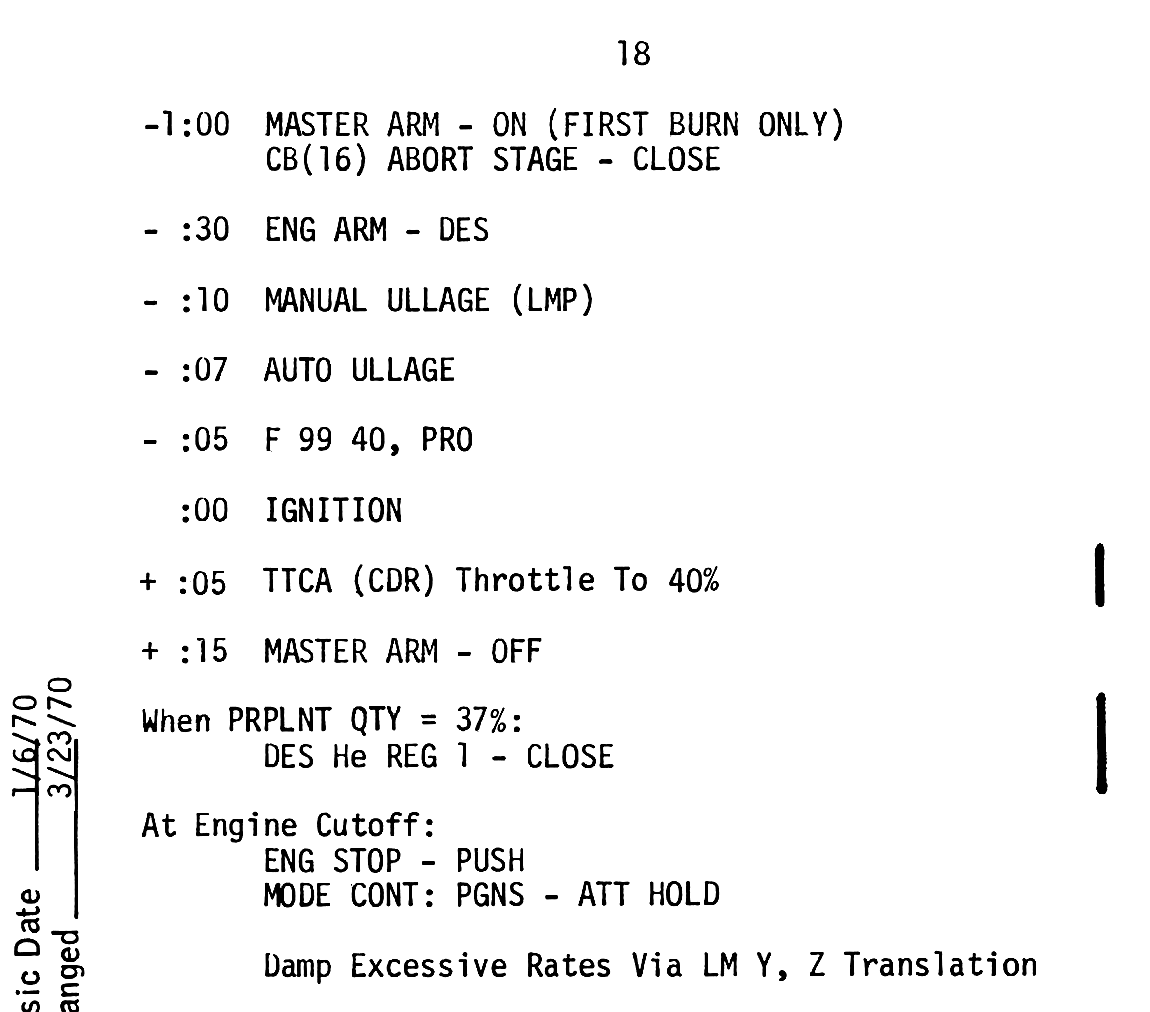
Page 18 of the LM Contingency Checklist
077:54:05 Brand: That's affirm. Before I start on the PADs, another comment. The general indications that we gave you before about the Sun being in the commander's window and about stars in the AOT, such as that might be used as general indication for your attitude for the burn, that's all out the window. We are just going on the Sun check that we made earlier and we don't feel that we have information that is good enough to give you the star and the Sun in the window information. [Pause.]
077:54:58 Lovell: [Garble].
077:55:05 Brand: Okay. You're very weak now. When you are ready to take the P30 LM maneuver PAD, I'll be reading it up. [Pause.]
077:55:20 Haise: Okay. Go ahead with the [garble].
077:55:24 Brand: Okay. This is P30, LM maneuver PAD, PC plus 2 hours, starting with Noun 33, 079:27:38.30; plus 0833.0, minus 0050.9, minus 0213.9; N/A, plus 0020.5; 0861.5, 4:24; 272, 081; and the rest is N/A except for comments as follows. Ullage, two jets, 10 seconds; CSM weight, 62480; LM weight, 33452 and the DPS throttle profile is the same as before, 5 seconds at minimum, 21 seconds at 40 percent, and the remainder of the time at Max. Over.
077:56:02 Haise: Okay, Vance. [Garble] 079:27:38.30; plus 0833.0, minus 0050.9, minus 0213.9; N/A, plus 0020.5; 0861.5, 4:24, 272, 081; and the rest N/A. Ullage, two jets, 10 seconds; CSM weight, 62480; LM weight, 33452. DPS throttle profile same as before, 5 seconds, 40 percent for 21 seconds, 40 percent, and the remainder at Max throttle [garble]. [Long pause.]
077:58:30 Brand: Okay, Aquarius; Houston. You're coming in about 1 by 1 now. Advise that I heard everything except the beginning Noun 33 values and the comments. Please repeat the readback on those.
077:58:48 Haise: Okay. I'm going to Up with the Power Amp here, Vance. [Long pause.]
077:59:15 Haise: Houston, how do you read Aquarius now?
077:59:17 Brand: Hey, you're loud and clear now.
077:59:23 Haise: Okay. I got the Power Amps now. PC plus 2 hours, 079:27:38.30; plus 0833.0, minus 0050.9, minus 0213.9; N/A, plus 0020.5; 0861.5, 4:24; 272, 081; rest N/A. Ullage, two jets, 10 seconds; CSM weight, 62480; LM weight, 33452; DPS throttle profile the same, 5 seconds idle, 40 percent at 21 seconds. Remainder at Max.
077:59:50 Brand: Roger. Forty percent for 21 seconds, I believe is what you read back. And all the rest is correct. Now, for the maneuver PAD for the CSM. Over.
078:00:29 Haise: Okay. Stand by. [Long pause.]
078:00:55 Haise: Okay. Go ahead.
078:00:58 Brand: Okay, Freddo. This is maneuver PAD monitor PC plus 2 hours; all N/A until you get to Noun 61. Latitude, minus 21.65, minus 165.00; 1163.5, 36292; 142:39:22. Over. [Pause.]
078:01:48 Haise: Monitor plane change plus 2; Noun 81, minus 21.65, minus 165.00; 1163.5, 36292; 142:39:22.
078:02:06 Brand: Roger. That was starting with Noun 61, and that's correct. [Long pause.]
078:02:25 Brand: By the way, Aquarius, we see the results now from 12's seismometer. Looks like your booster just hit the Moon, and it's rocking it a little bit. Over.
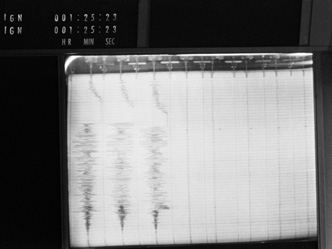
Seismographic data coming in live to Mission Control.
078:02:44 Lovell: Well, at least something worked on this flight. [Long pause.]
078:03:00 Brand: And I just want to verify one thing, we could...
078:03:02 Haise: Yes, I'm sure...
078:03:03 Brand: ...Go ahead.
078:03:09 Haise: I say, I'm sure glad we didn't have a LM impact, too.
078:03:16 Brand: Right. Just wanted to verify - We had poor reception when I was talking to you before - I wanted to verify that you understand that the Sun check you made earlier in the AOT was good, and that's what we're riding on. Anything that we told you in the past about looking at the Sun in the front left window or looking at stars, like Nunki through the AOT, why, we want to forget.
078:03:50 Lovell: Roger. Understand, Vance. I think Nunki would be kind of hard to see anyway with the Moon right here.
078:03:58 Brand: Right. [Long pause.]
Apollo Control, Houston; 78 hours, 4 minutes. Apollo 13 now 1,704 nautical miles [3,156 km] away from the Moon. Velocity now reading 5,768 feet per second [1,758 m/s]. Vance Brand passed up a new PC plus 2-hour maneuver PAD which reflected a time of ignition of 79 hours, 27 minutes, 38 seconds...
078:04:27 Lovell: And, Vance, we plan to start powering up at 78:12. Is that a good time or do you think we ought to hold off a little longer? [Pause.]
078:04:46 Brand: Jim, we think that's very good.
The Descent Propulsion System burn should produce a posigrade Delta-V of 861 feet per second [262 m/s] with this PAD. Burn duration; 4 minutes, 24 seconds. We're at 78 hours, 5 minutes now into the flight. This is Apollo Control, Houston.
078:08:23 Brand: Apollo 13, Houst - Aquarius, Houston.
078:08:31 Haise: Go ahead.
078:08:33 Brand: Fred, after the burn, we'll get the powerdown instructions, or checklist changes to you. At the same time, we'd like to get a consumables status to you. All I'll say right now is that we think you look in reasonably good shape.
078:08:52 Haise: Okay. Very good. [Long pause.]
078:09:46 Swigert: Okay. Houston, Aquarius.
078:09:48 Brand: Go ahead.
078:09:52 Swigert: Okay. One Caution and Warning light here showing that you didn't call out - it's the Pre Amps - I suppose because we don't have the ATCA breaker in yet.
078:10:08 Brand: Okay. That's okay.
078:17:38 Lovell: Houston, are you planning to give us a state vector update? [Long pause.]
078:18:04 Brand: That's - That's affirm, Jim. All we need is Updata Link circuit breaker closed on panel 11, and P00 and Accept and we can ship it up to you. P00 and Data. [Long pause.]
078:18:32 Lovell: Okay, Vance. We're in Data and P00 and the circuit breaker's in. Go ahead.
078:18:39 Brand: Okay. We'll ship her up to you.
This is Apollo Control, Houston; 78 hours, 20 minutes into the flight of Apollo 13. At present the Apollo 13 spacecraft is 2,461 nautical miles [4,558 km] away from the Moon and traveling a speed of 5,343 feet per second [1,629 m/s]. We show one hour and 7 minutes away from time of ignition of the Descent Propulsion System burn.
078:21:45 Brand: Aquarius, Houston. [Pause.]
078:21:53 Lovell: Go ahead, Houston.
078:21:54 Brand: Jim, request verify Ranging Function switch is in Ranging. We need that, if it's not there now. [Long pause.]
078:22:14 Swigert: You got it, Vance.
078:22:15 Brand: Thank you. [Long pause.]
Apollo Control, Houston; at 78 hours, 23 minutes now into the flight. The crew of Apollo 13 continuing to proceed on their activation checklist.
078:23:05 Brand: Aquarius, Houston. The computer is yours.
Flight Dynamics advises Flight Director Gene Kranz that there will be no requirement to update the PC plus 2 hours maneuver PAD.
078:28:15 Brand: Aquarius, Houston. Did you call? [Pause.]
078:28:22 Lovell: We didn't call, Houston.
078:29:41 Brand: Aquarius, Houston. Over. [Pause.]
078:29:48 Haise: Houston, are you calling Aquarius?
078:29:51 Brand: Roger, Fred. I would like to confirm that you are getting drinking water out of - potable water out of the Command Module and, if you can make any estimates of how much you use as time goes on, and how much you have used, we would appreciate it for our consumables analysis.
078:30:12 Haise: Okay. [Long pause.]
This is Apollo Control, Houston, at 78 hours, 30 minutes. We now show Apollo 13 at 2,900...
078:30:26 Haise: Okay, Jack. Tried the procedure and out of that pressure, we got 10 drinks made. That's roughly 80 ounces. [Long pause.]
We now show Apollo 13 2,958 nautical miles [5,478 km] away [garble].
078:30:56 Brand: Okay, Fred, we had a little static on that one, but I think you said that 80 ounces of water has been used out of the CM. Is that right?
078:31:08 Haise: Yes. Jack worked the procedure and filled as many of the drinks as he could, and he made up ten bags of approximately 8 ounces a bag.
078:31:23 Brand: Okay. We copy that.
Apollo 13, now traveling at a speed of 5,129 feet per second.
078:36:06 Brand: Aquarius, Houston. [Pause.]
078:36:14 Lovell: Go ahead, Houston.
078:36:16 Brand: Jim, just a bit of information, if for any reason you had to slip T
IG, our people here feel it wouldn't do much harm if you slipped it up to 30 minutes. The procedure, of course as you know, is not to Pro on the flashing 99 and we thought you might like to be aware that T
IG time isn't all that critical.
078:36:43 Lovell: Roger. Understand.
That discussion between Vance Brand and Jim Lovell was concerned with the time of ignition for the pericynthion plus 2-hour burn. We're 78 hours, 37 minutes now in the flight of Apollo 13. This is Apollo Control in Houston.
At 78 hours, 38 minutes, we now show Apollo 13 at a distance of 3,268 nautical miles [6,052 km] away from the Moon and at a velocity of 5,030 feet per second [1,533 m/s]. Our countdown clock shows 49 minutes, 30 seconds from time of ignition. This is Apollo Control, Houston.
078:41:07 Haise: Okay, Vance; Aquarius.
078:41:10 Brand: Go, Fred.
078:41:15 Haise: Okay. I think it's finally coming through to us here, what you said just a little while ago. Were you suggesting that we move the T
IG up 30 minutes?
078:41:25 Brand: No, not at all. We're just giving you excess information. Just saying if you had any problem at all it could be slipped.
078:41:38 Haise: Oh, okay. Slipped 30 minutes. Okay. That's better.
078:41:42 Brand: Right. [Long pause.]
078:41:55 Brand: You guys are pretty fast, though. [Pause.]
078:42:05 Haise: Yes. It kind of surprised us.
078:42:08 Brand: I guess that's what happens when you cut a lot out of a checklist.
078:42:14 Haise: Yes. Yes, we're taking about a thousand pictures in between steps there, too.
078:45:33 Haise: Okay, Houston; Aquarius, radio check.
078:45:39 Brand: Loud and clear, Fred.
078:45:43 Haise: Okay. I had a change in the background noises, wondered if you were still there.
This is Apollo Control, Houston; at 78 hours, 46 minutes now into the flight. We're 41 minutes away from scheduled time of ignition on our pericynthion plus 2-hour burn of the Apollo 13. Apollo 13 now 3,664 nautical miles [6,749 km] out from the Moon. Velocity now reading 4,913 feet per second [1,497 m/s].
Apollo Control, Houston; at 78 hours, 57 minutes into the flight. Flight Director Gene Kranz just advising his team that he will come - go around the room at about minus 10 minutes for a final Go/No-Go for the burn. We now show Apollo 13 at 4,146 nautical miles [7,678 km] away from the Moon and at a velocity of 4,791 feet per second [1,460 m/s].
079:06:25 Brand: Apollo 13, Houston.
079:06:28 Lovell: Houston, Aquarius. Go ahead, Houston.
079:06:31 Brand: Okay, Aquarius. We have some new information regarding what you should see out the commander's window at T
IG. Over.
079:06:44 Lovell: Okay. Go ahead.
079:06:48 Brand: According to calculations - calculations, you should see the Moon. It'll be a full Moon. You should see most of the disk and it should be somewhere on your vertical LPD line, probably at about 14 on the LPD scale. Over. Roughly centered on 14. [Long pause.]
079:07:38 Lovell: Okay, Houston. I concur. I'm looking at 14 on the LPD and the angle is just about centered. It's south of Crisium, but it's - The line is just slightly to the north of center. [Long pause.]
079:08:08 Brand: Okay, Jim. That sounds very good. We see that you have a slight yaw angle, so it should be north of center. [Long pause.]
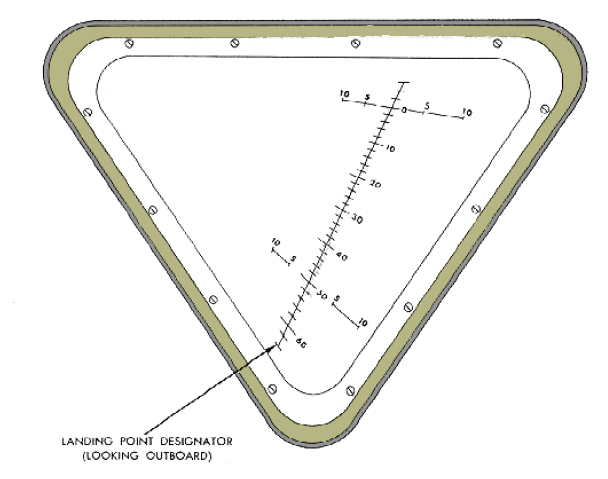
The Commander's window.
Apollo Control, Houston; seventy...
079:08:48 Lovell: I can even see Mount Marilyn from here.
The reference that Jim Lovell made there was one of the mountains that he named during his flight on Apollo 8.
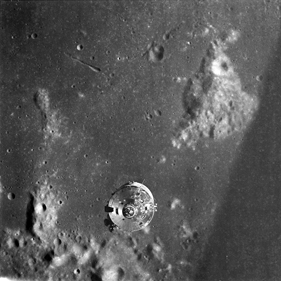
Mount Marilyn viewed from Apollo 10 LM, Snoopy, along with the CSM Charlie Brown.
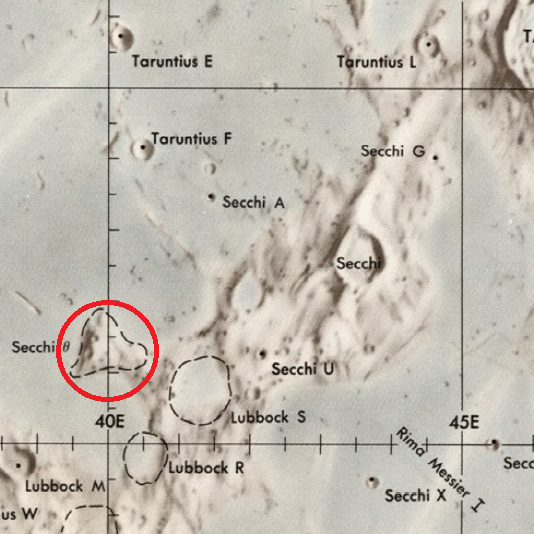
Map of the Secchi area, with Mt. Marilyn marked. NASA/LPI.
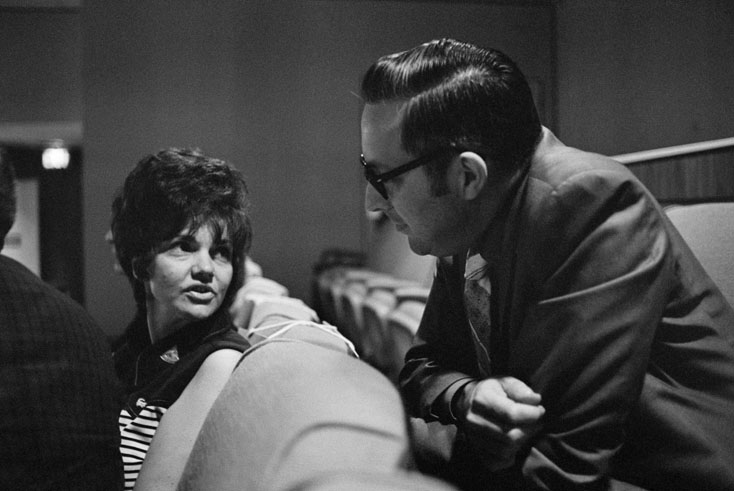
Marilyn Lovell in the viewing area overlooking Mission Control Room, photographed in conversation with Apollo Flight Surgeon Charles Berry.
This is Apollo Control, Houston. We're 79 hours, 10 minutes now into the flight, 18 minutes away from time of scheduled ignition on our pericynthion plus 2-hour burn. This will be performed by computer program 40 aboard the Lunar Module, the DPS thrusting program using the primary navigation and guidance system. Lovell and Haise will be in Aquarius at the time of the burn with Jack Swigert in Odyssey. We'll stand by and continue to monitor. We now show Apollo 13 at 4,717 nautical miles [8,736 km] out from the Moon and traveling at a speed of 4,675 feet per second [1,425 m/s]. This is Apollo Control, Houston.
Apollo Control, Houston; 79 hours, 13 minutes. Less than 15 minutes away now from time of scheduled ignition. We show 13 at a distance of 4,839 nautical miles [8,962 km] out from the Moon and at a velocity of 4,651 feet per second [1,418 m/s]. Within the next several minutes, Flight Director Gene Kranz is expected to go around the room for Go/No-Go status from each member of his flight control team. We're at 79 hours, 14 minutes into the flight; continuing to monitor. This is Apollo Control, Houston.
Apollo Control, Houston; 79 hours, 17 minutes. Flight Director Gene Kranz now going around the room for Go/No-Go status from each member of his team. We're Go for the burn. Apollo 13 now 5,039 nautical miles [9,332 km] away from the Moon, traveling at a speed of 4,616 feet per second [1,407 m/s].
079:18:07 Brand: Aquarius, Houston. Over.
079:18:13 Lovell: Go ahead, Houston.
079:18:15 Brand: Jim, you are Go for the burn. Go for the burn.
079:18:20 Lovell: Roger. I understand. Go for the burn.
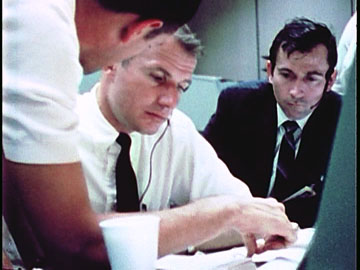
Vance Brand as the CapCom, with John Young in for support.
This is Apollo Control, Houston. We're a little over 6 minutes now away from time of scheduled ignition. 79 hours, 21 minutes. Meanwhile at Mission Control, both the viewing room and the floor of Mission Operations Control Room have filled up with a considerable number of people. Among those here tonight are Dr. Thomas Paine, Nasa Administrator; Mr. George Low, Deputy Administrator of NASA; Frank Borman, who commanded the flight of Apollo 8 and Gemini 7 and had a flying companion named Jim Lovell; Ken Mattingly is here; Al Shepard, commander of Apollo 14, is on the MOCR floor at this time as is Ed Mitchell, the Lunar Module Pilot, along with Stu Roosa who is scheduled to fly in the Command Module on that flight. We're coming up on 5 minutes until scheduled time of ignition. Gene Kranz has checked with couple of his systems, or members of his flight control team who monitor systems. They indicate they are happy with the data they are looking at now. We're standing by and continuing to monitor, this is Apollo Control, Houston.
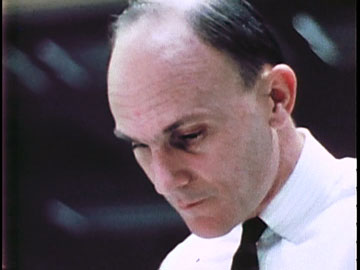
Ken Mattingly, about to observe the PC+2 burn.
Apollo Control, Houston; 79 hours, 23 minutes into the flight. We show Apollo 13 at 5,263 nautical miles [9,747 km] relative to the Moon, and traveling at a velocity of 4,578 feet per second [1,395 m/s].
Apollo Control, Houston, less than 3 minutes away now from scheduled time of ignition as we look at one of our displays in the Mission Control Center, we see that Apollo 13's Lunar Module is now in program 40, that's the Descent Propulsion System thrusting program...
079:24:16 Brand: Aquarius, 2 minutes and 40 seconds to go on the Mark.
079:24:22 Brand: Or that was - Stand by.
079:24:24 Lovell: What was that mark?
079:24:26 Brand: Stand by. That was incorrect. Three minutes - Counting down to 3 minutes, and I'll give you a mark, and I'll take into consideration 2 seconds.
079:24:41 Lovell: Roger. We got you.
79 hours, 25 minutes into the flight, Apollo 13 now at a distance of 5,349 nautical miles [9,906 km] away from the Moon. Velocity now reading 4,564 feet per second [1,391 m/s] relative to the Moon.
Less than 2 minutes away now from scheduled time of ignition. Velocity reading 4,560 feet per second [1,390 m/s]; distance from the Moon, 5,383 nautical miles [9,969 km].
One minute away now from scheduled time of ignition.
079:26:43 Haise: One minute.
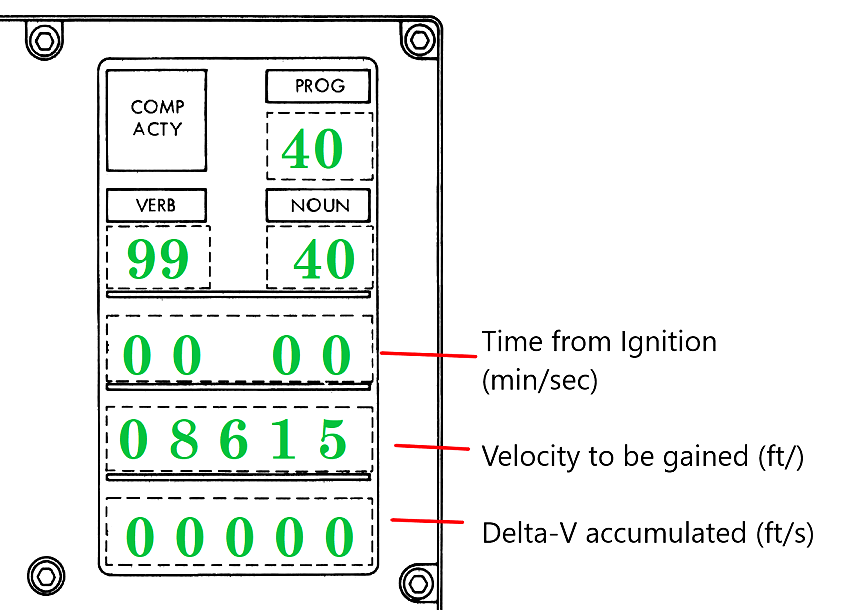
Recreated view into the DSKY display while counting down to the PC+2 burn. The three lines show the time left, the amount of velocity that remains to be gained, and the actual amount of velocity gained as measured by the IMU.
Apollo 13 now 5,426 nautical miles [10,049 km] out from the Moon, traveling at a speed of 4,552 feet per second [1,387 m/s].
Less than 30 seconds away.
The engine is armed. Standing by.
Ground confirms ignition.
079:27:51 Lovell: We're burning, 40 per cent.
079:27:54 Brand: Houston copies. [Long pause.]
Attitude looks good at this point.
079:28:09 Lovell: One hundred per cent.
079:28:11 Brand: Roger. [Long pause.]
079:28:31 Brand: Aquarius, Houston. You're looking good.
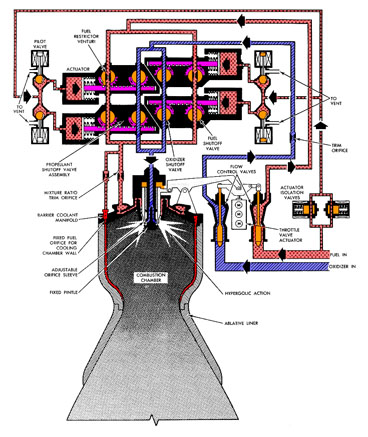
Diagram of the Descent Propulsion System.
1 minute now into the burn.
DPS is looking good, 2 minutes into the burn.
079:29:52 Brand: Aquarius, you were looking good at 2 minutes. Still looking good.
079:29:58 Lovell: Two minutes. Roger. [Long pause.]
Velocity building up. Our DSKY shows we've gained 451 feet per second at this time.
Reports to Flight Director Gene Kranz indicate all systems are looking good. Coming up on 3 minutes into the burn.
079:30:43 Brand: Aquarius, you're Go at 3 minutes.
079:30:49 Lovell: Aquarius. Roger. [Long pause.]
The onboard display shows less than a minute to go on the burn now.
Coming up on 4 minutes into the burn.
079:31:46 Brand: Don't forget Descent Reg 1, off; 10 seconds to go. [Long pause.]
079:32:05 Lovell: Shutdown.
079:32:07 Brand: Roger. Shutdown. [Long pause.]
That was Commander Jim Lovell reporting shutdown, the engine is off. We're at 79 hours, 32 minutes into the flight.
079:32:31 Lovell: Are you reading our 16 40, Houston?
079:32:36 Brand: Roger. We're reading it.
079:32:41 Lovell: We'll proceed. Here's our residuals. [Pause.]
079:32:52 Brand: Roger. Very small. [Pause.]
Apollo Control; 79 hours, 33 minutes, 5,707 nautical miles [10,569 km] out from the Moon at this time.
079:33:07 Brand: Good burn, Aquarius.
079:33:12 Lovell: Go ahead.
079:33:13 Brand: I say, that was a good burn.
079:33:18 Lovell: Roger. And now we want to power down as soon as possible.
079:33:23 Brand: Roger. Understand. [Long pause.]
We're at 79 hours...
079:33:56 Lovell: Houston, Aquarius.
079:33:58 Brand: Go ahead.
079:34:02 Lovell: Suggest maybe you just read off the circuit breakers you want us to power down. As you did yesterday, for us.
079:34:09 Brand: Okay. We have a procedure ready to send up to you here in about 2 minutes. Let us know when you're all ready to take it.
079:34:23 Haise: Okay. Is it going to be better to write this on a blank page, Vance, or can we use some portion of the powerdown list there in the contingency book that already exists.
079:34:33 Brand: Stand by 1.
079:36:03 Brand: Aquarius, Houston. Over.
079:36:07 Lovell: Go ahead.
079:36:08 Brand: Slight delay here, Jim. It will be a couple of minutes before we read that up to you, and we're looking at the contingency checklist powerdown and that's on page 5. You might be getting that out while we get all ready to give it to you. [Long pause.]
Apollo Control, Houston; 79 hours, 37 minutes into the flight...
079:37:03 Haise: Vance, could you give us that page number again. Page 5 doesn't make sense. [Pause.]
079:37:14 Brand: Okay. Make that power 5 in the contingency checklist, Fred. And it's the...
079:37:24 Haise: ...that's better.
079:37:25 Brand: ...middle part of the page, it starts emergency powerdown, and we'll mark that up. [Long pause.]
We're at 79 hours, 37 minutes into the flight. Guidance has reported that the burn duration was literally right on the money.
079:37:42 Haise: Okay. I'm to 5, Emergency powerdown.
079:37:48 Brand: Okay. But hold off on it because we might have to start PTC up again here. And that's the point that's being resolved right at the moment, so stand by.
Apollo Control Houston. The term PTC, Passive Thermal Control is a bar-b-que mode which has been used on previous flights. There's a discussion in the control center as to whether or not we should continue it in that mode during the coast phase in. We're 79 hours, 39 minutes into the flight and continuing to monitor; this is Apollo Control, Houston.
Apollo Control, Houston; 79 hours, 40 minutes into the mission. We show Apollo 13 at 6,003 nautical miles [11,118 km] out from the Moon. At this time, traveling at a speed of 4,980 feet per second [1,518 m/s].
079:42:19 Brand: Aquarius, Houston. Over.
079:42:25 Lovell: Go ahead, Houston.
079:42:26 Brand: Okay. We're ready to give you the procedure which will power you down a good bit, and after the PTC is going, maybe we can give you further information. Are you ready to copy? Starting at the middle of the page, power 5. [Pause.]
079:42:48 Haise: Okay. Go ahead, Vance.
079:42:51 Brand: Okay. After number 1, first line, cross out "And VHF-A." Second line, cross out "Simplex operation." Third line, cross out "Prime." That refers to Prime Power Amp, Off. That - that "Prime" should actually be replaced by Off. And that's the second prime that line. Also in the third line the last word "Off" should be crossed out and replaced by "PCM." Fourth line is okay. Fifth line, which is "VHF Voice, On, Off, Off," cross out. "Lighting, Floods," which is the next line should be "Off", but add the following, "Or Overhead/Forward prefer Off." Okay. Step 2 remains the same; no change for the moment. Stand by. Skip step 2. Do not do it. Just go on to step 3, which is "Configure circuit breakers per the chart." That takes us to page power 6. Why don't you give me a readback on what you had on power 5, Freddo.
079:44:48 Haise: Okay. On power 5, emergency powerdown. Item 1, first line, I scratch the "And VHF-A." Second line "Simplex operation." Third line, I replace the second "Prime" which is the Power Amp with an "Off," and the last word in that line is "Off," replaced it with "PCM." Fourth line is okay. Fifth line, I scratch the whole line. Lighting, we haven't needed floods yet so we will just leave them off, exterior lighting off. Scratch line 2 and I am now on power 6, wait for your update on the CB panels.
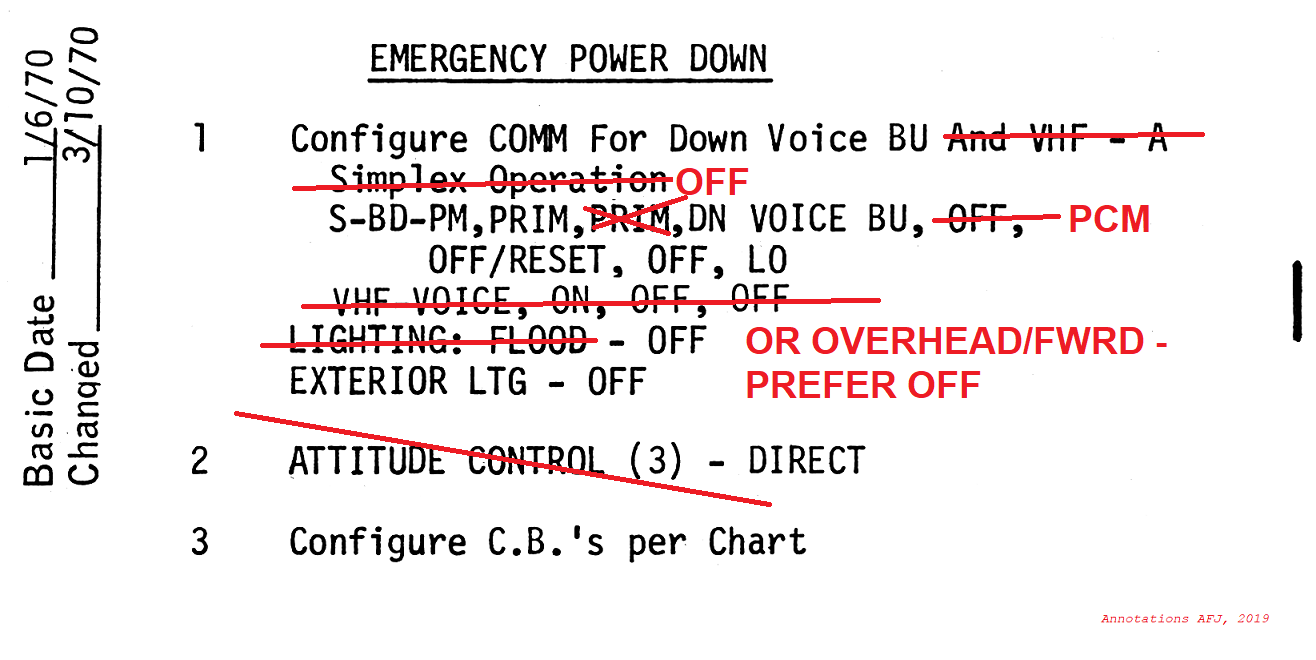
Power-5 page from LM Contingency Checklist
079:45:31 Brand: Okay. Power 6. Okay. Power 6 refers to panel 11. You should go per the chart with the exception of those breakers that I call out. First line is okay. Or, let's say, first row. Second row, Quad 4, TCA, closed; Quad 3, TCA, closed; Quad 2, TCA, closed; and Quad 1, TCA, closed. The rest of that row is okay. Row 3, about halfway over, ATCA (PGNS), closed. Okay. The rest of that line is okay. Fourth line, Heater - stand by. Okay. That line is all okay with the exception of the last three circuit breakers, Fred, under PGNS, which is LGC DSKY, IMU Standby, IMU Operate. Those three should be closed, at least for the time being. And finally, the fifth line; it's okay as is. And would you give me a readback on that?
079:47:35 Haise: Okay. I disagree on the fifth line. It appears that we ought to have the Ascent ECA Control, Open.
079:47:49 Brand: Okay. We'll check into that one and while we are listening to the rest of your readout.
079:47:57 Haise: Okay. And top row is correct as is. Second row we want the Quad TCAs 1 through 4 closed. On the third row, we want the ATCA (PGNS), closed. On the fourth row we want the PGNS LGC DSKY, IMU Standby, IMU Operate, all closed, and you're saying the bottom row as is.
079:48:23 Brand: Okay. We'll go along with what you said on the Ascent ECA Control. That should be open. [Pause.]
079:48:38 Lovell: Okay. Continue, Vance.
079:48:41 Brand: Okay. Next page, power 7, panel 16. First row, close the four Quad TCA circuit breakers, that is, Quad 1, TCA; Quad 2, Quad 3, and Quad 4 TCA. Okay. Rows 2, 3, and 4 are okay. [Pause.]
079:49:17 Haise: Okay. Panel 16, top row, we want to close Quad 1 through 4 TCA breakers, and you're saying the other three rows are as is. Again, I have the exception; the Ascent ECA Control on 16 should also be Open.
079:49:35 Brand: Okay. We concur on that, and we have a late arrival in row 3. Stand by. [Pause.]
079:49:52 Brand: Okay, Fred. One addition, third row. The S-Band Power Amp. Request that you pull that circuit breaker and leave the switch in Primary.
079:50:10 Haise: Okay. Yes, that's the way we were doing it before. I'll pull the Power Amp CB, and then I'll go back to the first stage and put the Power Amp to Prime.
079:50:22 Brand: That's correct; that should be changed back to Prime. And that's - That's it. [Long pause.]
Apollo Control, Houston; 79 hours...
079:50:42 Lovell: Good work, Vance.
079:50:46 Brand: Thank you. [Pause.]
...51 minutes into the flight. That was Vance Brand going through a checklist with the Apollo 13 crew for procedures in powering down the systems.
079:51:00 Haise: Reset, Off and Low. Okay. Lighting bus, Off; Exterior Lighting is Off. Okay. You want to get your breakers, Jim?
We now show 13 at 6,515 nautical miles [12,066 km] out.
079:51:16 Haise: We ought to probably go back to that wide deadband.
079:51:24 Lovell: Okay. The Bus Tie Inverters are coming off the line.
079:51:28 Haise: Yes. Go ahead. Sorry, I put the switch off. That'll kill caution and warning. [Long pause.]
079:52:02 Lovell: Okay. Let's see. So we're going to lose the ball again.
079:52:11 Haise: I'll get 16 Noun 20 up. [Long pause.]
079:52:53 Lovell: Do you have me move Auto Transfer this time? [Long pause.]
079:53:07 Lovell: Why do I still have a VHF-A receiver off?
079:53:13 Haise: You don't, do you?
079:53:16 Lovell: Why don't you give them a call, panel 11.
079:53:19 Haise: Okay, Vance. I'm on - Do you read me now, hot mike?
079:53:23 Brand: Roger. Loud and clear, Fred.
079:53:26 Haise: Okay. Jim just noticed we got a VHF breaker in on panel 11 still, I think, that probably should be opened. [Pause.]
079:53:41 Brand: Okay. That's affirmative. Pull the VHF-A receiver.
079:53:54 Haise: Okay. Pull it, Jim.
079:53:55 Lovell: I got it already. Okay. Now, why are we putting the cabin fan on?
079:54:06 Lovell: Oh, oh, oh. Oh, yes. Okay. [Long pause.]
079:54:23 Lovell: Okay. I'm going to pull inverter 1.
079:54:24 Haise: Okay. Not very long since they had the switch off on you, anyway.
079:54:32 Haise: Roger...
079:54:33 Lovell: - but my only question is, I got the Cross Tie Bus circuit breaker in? Could be - Yes, this one right here.
079:54:50 Haise: Good line. It's on. Because that line is open. [Long pause.]
079:55:21 Haise: I'll look over at that caution in a minute. [Long pause.]
079:55:53 Haise: Vance, Aquarius.
079:55:56 Brand: Roger. Go ahead, Fred.
079:56:01 Haise: Yes. We've managed the first 30 hours or so here without the caution and warning; we don't need to keep it up now, do we? [Long pause.]
079:56:27 Brand: Okay, Fred. That's one that we're leaving up until the PTC is established. We have a procedure for PTC to try with you, which we're hopeful will work pretty well. And I'll read that up as soon as you get what you're doing now done.
079:56:44 Lovell: Why don't you go ahead, and I'll get this PTC procedure. It's by the photo log, and I'll just get that. [Long pause.]
079:57:05 Haise: And one other question, Houston. You really want to pull the ASA breaker? You want to give up the AGS probably for good now, huh? [Long pause.]
079:57:33 Lovell: Houston, I'm standing by to copy the PTC procedures
079:57:39 Brand: Okay. I'll get back with you on your question in a minute, Fred. Now, here comes the PTC procedure. Step 1, Guidance Control to PGNS; 2, Mode Control, Att Hold; Verb 76, Enter; maneuver to PTC attitude; and that incidentally is roll 0, pitch 90, and present yaw. We realize you can't monitor that on your FDAI, but you can on a verb, with a Verb 16, Noun 20.
079:58:20 Brand: With me?
079:58:40 Lovell: Roger. Guidance Control, PGNS; Mode Control, Att Hold, Verb 76, Enter; maneuver to PTC attitude which is roll 0, pitch 90, and yaw, which is the present yaw. Is that correct?
079:58:54 Brand: That's correct. Okay. Next. Mode - at - When you're established at the attitude, Mode Control, Auto. Key in Verb 16, Noun 20 to monitor rates; when less than 0.1 degree a second, rate in all - in each axis, then disable plus-X thrusters. Okay. Next, Verb 25, Noun 07, Enter; 1257, Enter; 252, Enter; 1, Enter; Verb 77, Enter; Verb 48, Enter; put in the DAP, 22110 and Proceed; Verb 34, Enter; then Verb 16, Noun 20; and monitor rates. On rates less than 0.01 degrees per second in all axis: Verb 76, Enter; Mode Control, Att Hold; then 30 clicks of right yaw to start the maneuver. Over. [Long pause.]

Verb 25 Noun 07 procedure.
080:01:48 Lovell: Okay, Vance. PTC procedure: Guidance Control, PGNS; Mode Control, Att Hold; Verb 76, Enter; maneuver to PTC attitude; roll 0, pitch 90, yaw 0; my ball now, of course, is inoperative, so I'll have to get that on the DSKY. The 5 is Mode Control, Auto; 6: Verb 16, Noun 20, monitor rates; rates less than 1 degree per second in each axis, disable, and I didn't hear that last part. The next one was Verb 25, Noun 07, Enter; 1257, Enter; 252, Enter; 1, Enter; Verb 77, Enter; Verb 48, Enter; 22110, Proceed; Verb 34, Enter; Verb 16, Noun 20, Enter; monitor rates. Rates less than 0.01 degrees per second in all axis. Verb 76, Enter; Mode Control, Att Hold; then 30 clicks of right yaw to stop - to start - maneuvers.
080:03:04 Brand: Roger. That's correct, Jim. To - to answer your questions and correct one point, yaw should be your present yaw, whatever it is, and that's up with roll 0, pitch 90, present yaw. The other thing is, you said disable and you didn't hear the rest. That's disable plus-X thrusters. And finally, near the end, the 22110 refers to DAP loading. [Pause.]
080:03:48 Lovell: Roger. Now, to maneuver to PTC roll 0, pitch 90 and yaw is - and pitch is here, roll is here. Yaw - whatever yaw we have in. Okay, Vance. In our initial maneuver to PTC attitude, I am going to have to use - to display 16 20 and I'll have to use the TTCA to get there. [Long pause.]
080:05:01 Brand: Jim, Roger. Your use of the TC - TTCA and just a reminder that in maneuvering that - that - that roll is in R3 and yaw is in R1.
080:05:17 Lovell: That's affirm. And I'm going to take out roll first to get it zero and then I'm going to take care of pitch.
080:05:24 Brand: Okay. [Long pause.]
080:06:07 Lovell: Okay. Guidance Control, PGNS; Mode Control to Att Hold. Verb 73 clears. Okay. We've got to get that out. [Garble] it stopped moving. [Pause.]
080:06:54 Lovell: Here we go. [Long pause.]
080:07:32 Lovell: [Garble] the battery. [Garble]. [Long pause.]
080:08:27 Lovell: Do you know what the plus-X thrusters are? [Long pause.]
080:08:41 Lovell: Yes, okay. I just wanted to make sure you do. I got them over here. [Pause.]
080:08:55 Brand: Aquarius, Houston. Over.
080:08:59 Lovell: Go ahead.
080:09:01 Brand: Okay. A couple of things, Jim. One is that you can use the TTCAs to maneuver, but you're going to save a lot of fuel if you'd try Minimum Impulse. So, that might be a better recommendation. The other thing is, we'd like to give you a Go before you disable the plus S - X thrusters, and before you do a Verb 76, and Mode Control to Att Hold. Over. [Pause.]
080:09:40 Lovell: Okay; understand. You want a Go before I - I'm - Of course, I just did a 76, and the Mode Control is in Att Hold, at this time. But, this is later on down. [Pause.]
080:10:04 Brand: Yes. All we wanted to do was take a look at things before you disabled the plus-X thrusters, and before you go to Min Impulse at the end there - that Verb 76, Enter; Mode Control, Att Hold.
080:10:20 Lovell: Roger. Understand. And I'm maneuvering my roll now to zero.
080:10:25 Brand: Roger. [Long pause.]
080:10:51 Lovell: Yes. Those are the plus-X, right? [Pause.]
080:11:03 Haise: Houston, Aquarius
080:11:07 Brand: Go ahead, Aquarius.
080:11:12 Brand: Go ahead.
080:11:13 Haise: In what fashion did you want us to disable those plus-X thrusters? Just pulling those appropriate TCA breakers, or did you want to actually go in and mask those jets? [Pause.]
080:11:33 Brand: Okay, Fred. We didn't explain that. The Verb 25, Noun 07, Enter sequence does that.
080:11:43 Haise: Okay. I didn't read the whole procedure. Jim just mentioned he wanted to disable plus-X.
080:11:49 Lovell: I just did.
080:11:50 Haise: Okay. [Long pause.]
080:12:32 Haise: And, Vance, are you still trying to get me an answer on that - pulling that ASA breaker?
080:12:44 Brand: That's affirm, Fred. This - The word here is, pull it.
080:12:53 Haise: Okay. Sure didn't get much work out of the AGS this time.
080:14:43 Haise: It's going slightly.
080:14:45 Lovell: So is this one. [Long pause.]
080:15:26 Haise: Yes. You got a ways to go in pitch.
080:15:30 Haise: [Garble] 80.
080:16:46 Lovell: You want to rest a little bit?
080:16:52 Haise: What time is it, 9:30? I got an about what? I think I got about 10.
080:18:49 Lovell: We're now in the hands of tracking.
080:18:52 Haise: Yes. It looks different than before. [Pause.]
080:19:09 Haise: Hard to do P37 in the LM. Hard to do a P37 in the LM. [Long pause.]
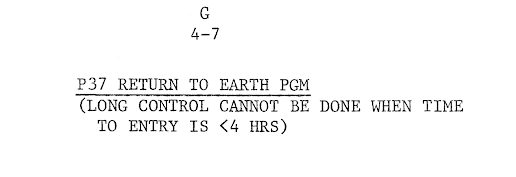
P37 procedure start from the CSM G/N Checklist.
080:19:52 Lovell: Well, you can see where...
080:19:55 Haise: You almost can see...
080:19:57 Lovell: ...See Ptolemaeus, Alphonsus - There's Herschel. [Pause.]
080:20:13 Haise: Yes, you can barely see it in the corner there.
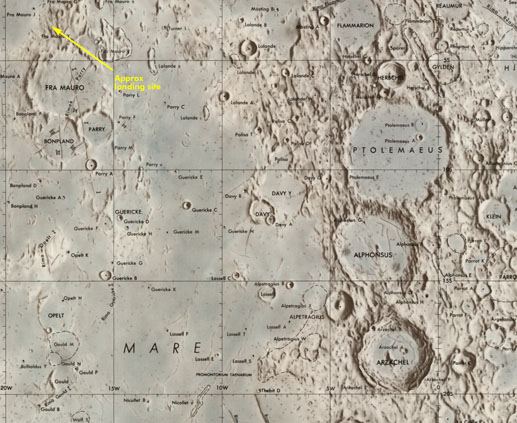
Craters east of Fra Mauro. NASA/LPI
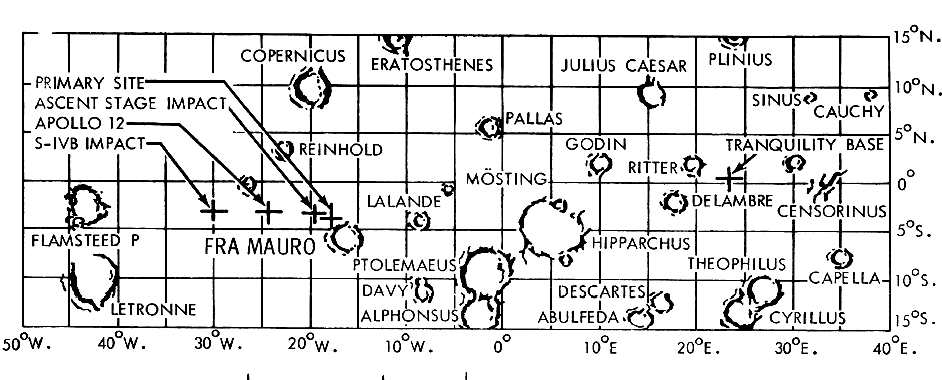
Landing site map for Apollo 13. From the A13 Press Kit.
080:20:18 Brand: Aquarius, Houston.
080:20:23 Lovell: Go ahead, Houston.
080:20:25 Brand: Okay. Just some info. We're working up a procedure for you to use - to - to use Command Module LiOH canisters to connect to your hoses - the outlet hoses in the LM so that, as time passes in the mission, you can continue scrubbing the LM atmosphere. And this whole thing requires modifying a kit so that you can attach the hose modifying a LiOH canister, so you can attach the hose to it. So, sometime in the future, we will be coming up to you with that procedure. Second point - Second point is, we're standing by to watch your maneuver for the PTC procedure. Over.
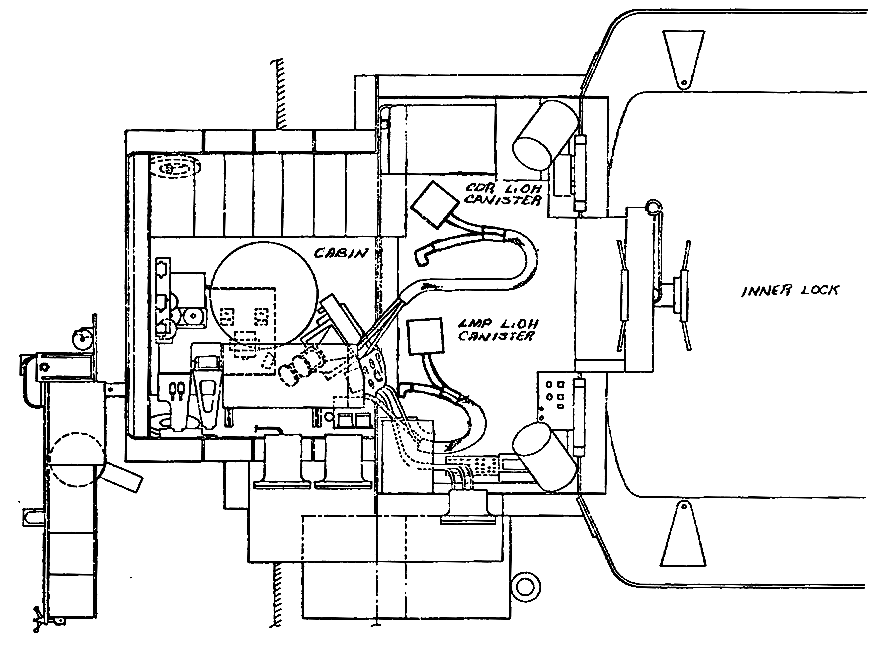
Apollo 13 LiOH Canister Evaluation. The 11-foot environmental chamber layout for the canister test. A complete LM ECS circuit could be used to simulate the LM environment.
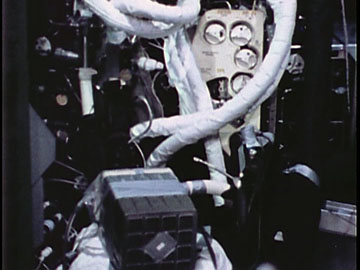
Film caption of the canister adapter prototype in the 11-foot environmental test chamber.
080:21:16 Lovell: Okay. I'm in process now, Vance, of maneuvering to zero yaw, 90-degree pitch, using Minimum Impulse.
080:21:25 Brand: Okay. [Long pause.]
080:21:42 Haise: And, Vance, I assume it had also been brought up that we got two extra secondary cartridges - one in each PLSS.
080:21:55 Brand: Roger. [Pause.]
080:22:07 Lovell: We ought to start working on that mod right now.
080:22:13 Brand: Yes. We wish we could send you a kit and it would be kind of like putting a model airplane together or something. As it turns out, this contraption will look like a mailbox, when you get it all put together.
080:22:28 Haise: What do we make it out of, Vance?
080:22:32 Brand: One canister with a...
080:22:35 Haise: ...How about planning a rendezvous procedure?
080:22:38 Brand: ...with a plastic roof. [Pause.]
080:22:50 Lovell: Just for information, Houston, during - Just prior to going around the Moon, we saw a lot of debris that was floating by us, including some - one rather large piece looked like the wrapping off of a line of some sort that is - still is with us.
080:23:10 Brand: Roger. Copy, Jim.
080:23:16 Lovell: Even after our free-return midcourse yesterday.
080:23:24 Brand: Okay. We copy that. [Long pause.]
080:23:40 Lovell: No matter what I do, I can't stop that. Roll either way won't do it.
080:23:49 Haise: Jim? [Long pause.]
080:24:06 Haise: Well, I don't see any way around it, Jim. It sure doesn't seem to be doing much, does it? It won't go down. [Long pause.]
080:24:29 Lovell: I don't know. I wonder if they tried that in the simulator. I can't seem to get roll to go up. It goes down on me, no matter how I hit the controllers. [Pause.]
080:24:45 Lovell: Got pitch zero. [Pause.]
080:24:56 Lovell: You can really see a change in rate?
080:24:59 Haise: [Garble] yaw here, see if it'll couple in roll. [Long pause.]
080:25:15 Haise: No? [Pause.]
080:25:26 Lovell: There we go. [Long pause.]
080:25:45 Haise: That does it. [Pause.]
080:25:54 Haise: I'm glad, too.
080:26:00 Lovell: I don't know what caused it.
Apollo Control, Houston; 80 hours, 27 minutes. Apollo 13 now 8,137 nautical miles [15,070 km] out from the Moon. And presently traveling at a speed of...
080:27:36 Lovell: Here we still have 67-percent fuel level. I wonder how come they didn't [garble] Delta-V curve? [Long pause.]
080:27:56 Brand: Aquarius, Houston.
080:27:59 Lovell: Go ahead.
080:28:01 Brand: Jim, we don't have any data on your movements right now. How does it look like this procedure's going to work out so far as getting an attitude set up, the first part of the procedure?
080:28:19 Lovell: Well, Vance, I've been trying to use Minimum Impulse only attitude control to get my roll and yaw - the roll and pitch, rather. But, with the attitude control only in this configuration, I - I can't command these - the roll the way I want to. So, I had to go to TTCA to get my roll to build up towards zero, it was going - decreasing towards 270. I really don't know what the combination is in the attitude control, that you can get the control to pitch and roll the way you want it to. You've got to use the TTCA.
080:29:00 Brand: Roger. Copy.
080:29:04 Lovell: I now have both pitch and yaw - or pitch and roll going toward the designated amounts, now passing through 23 degrees in pitch, and I'm going up past 321 degrees in roll. And I am letting go that direction and when I get there, 90 in pitch and zero in roll, I'll go to Auto and damp the rates. [Long pause.]
080:30:00 Lovell: Get a little sleep? That's okay. [Long pause.]
080:30:28 Lovell: We've got to rig up a method of using those lithium hydroxide canisters. [Long pause.]
080:30:53 Haise: Okay, Houston. We just got a Master Alarm and an ECS light. I take it the partial pressure CO
2 is - yeah - that's what tripped it. [Long pause.]
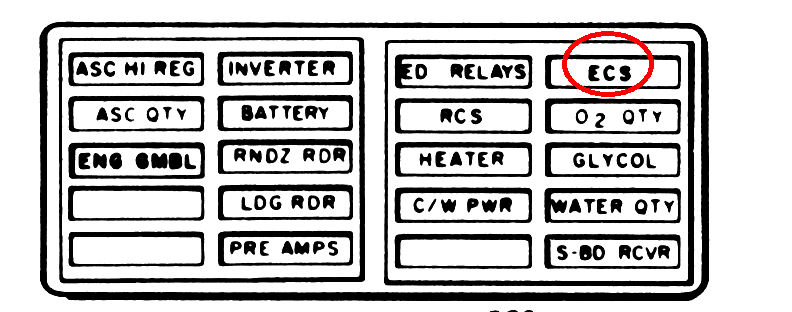
LM right side Caution and Warning panel. Scan via heroicrelics.org
080:31:15 Haise: There's that mother.
080:31:19 Brand: Aquarius, Houston. Say again.
080:31:20 Lovell: Oh what was that? CO
2? All right. CO
2 value is getting high. We had a [garble] ECS light and a blinking component light.
080:31:37 Brand: Okay. Copy. [Long pause.]
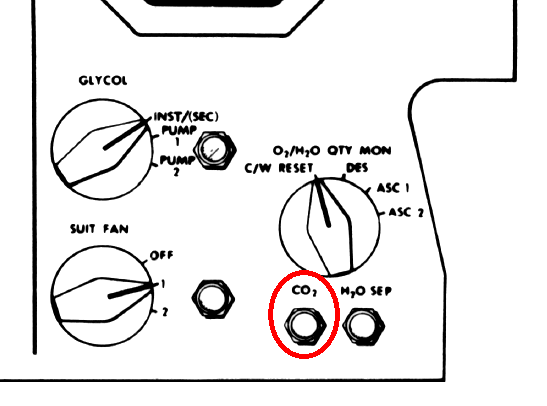
Bottom of the SE/LMP's console, showing the ECS controls and the CO2 light. Via heroicrelics.org
080:32:14 Brand: Stand by on that PPCO
2.
080:32:20 Lovell: Say again, Houston. [Long pause.]
080:32:41 Lovell: Hello, Houston. How do you read? Over.
080:32:43 Brand: Okay. Read you loud and clear now, Jim.
080:32:48 Lovell: Okay. Did you hear what I just said about the ECS light and the blinking CO
2 component light?
080:32:54 Brand: Okay. We got that and - Stand by 1.
080:33:01 Lovell: Okay. [Long pause.]
080:33:17 Haise: Not much. [Long pause.]
080:33:34 Lovell: Jack, we might have to have you rig up this CO
2 rig they're talking about.
080:33:42 Brand: Aquarius, Houston. Over.
080:33:42 Lovell: Go ahead. Houston. Over.
080:33:43 Swigert: Oh! We've got a long ways to go.
080:33:47 Lovell: Go ahead.
080:33:49 Brand: Okay, Jim. We're going to have to get back with you in a couple of minutes on whether or not we switch over at this time to your other canister. Second point, it might help in setting up this PTC if you concentrate on roll first, and get that going; and then work on pitch, when roll is established, and sort of take whatever yaw you get
080:34:21 Lovell: Okay. Vance, I tried that but when I start doing roll only I get pitch coupled in with it. But both of them rolling up toward this desired amount, though. I'm up to 46 and in pitch and 326 in roll.
080:34:42 Brand: Okay. Understand you've tried it. [Pause.]
080:34:55 Lovell: Once I get roll zeroed, I don't think it'll be too bad. [Long pause.]
080:35:53 Haise: [Laughter.] [Pause.]
080:36:01 Lovell: So what did they put on my LEVA? [Pause.]
080:36:15 Haise: Oh, boy. [Pause.]
080:36:23 Swigert: [Garble]?
080:36:25 Haise: No. He didn't want it. There she goes, gang. The Moon.
080:36:40 Brand: Aquarius, Houston.
080:36:45 Lovell: Go ahead, Vance.
080:36:46 Brand: Okay, Jim. Since the first recommendation on how to maneuver PTC didn't work out, we have another one. And you might try this. Put yaw at zero, then start the roll, and the pitch after that. [Long pause.]
080:37:27 Haise: Vance, do you read?
080:37:29 Brand: Yes. I do now. Go ahead.
080:37:33 Haise: Okay. You guys just tell me what sort of material you had in mind to build this mailbox out of, and Jack and I will go to work on trying to construct that thing. Assume we'll use the space-age baling wire or the gray tape?
080:37:51 Brand: That's affirm. We have a lengthy procedure here; but, in short, you use plastic as a covering for the whole thing. You put some kind of a stiffener at the top so the plastic doesn't suck against the LOI - LiOH enter - entrance side. You'll - You need gray tape to stick the whole thing together, and you need something like a sock to put in the - the bottom so that the outlet side is plugged up. As it turns out, the flow is rather U-shaped through the cartridge, Fred. It, if you plug up the bottom, it comes in one side of the top and goes out the other.
080:38:45 Haise: Okay. (Sigh) Hold on a minute. Let - Let us go get a cartridge and with it in hand, I'll speak to you some more. [Pause.]
080:39:01 Brand: Aquarius, Houston. Over.
080:39:03 Lovell: Okay, Vance. Go ahead.
080:39:06 Brand: Okay. Really, I think we should give you a more detailed procedure on that; and, in general, those are the materials that are to be used, but let us get back with a detailed procedure on how to make this cartridge arrangement work.
080:39:27 Haise: Okay. [Pause.]
080:39:38 Lovell: And to answer your question about PTC, Vance, it's rather difficult to use yaw in zero right away. So what I'm doing, yaw is working toward zero, right now. Pitch is working toward 90, and roll is working toward - zero. So, we - We're just going to take some time to get there, that's all.
080:40:08 Brand: Roger. Quite a bit of noise now. I understand you're still having a problem getting there with the PTC.
080:40:19 Lovell: We are getting there slowly.
080:40:21 Brand: Okay. [Long pause.]
080:40:42 Brand: Aquarius, Houston. Let's try Forward Omni. [Long pause.]
080:41:38 Lovell: I don't know, it looks [garble] [Pause.]
080:41:47 Lovell: I don't know, it looks that way. [Long pause.]
080:42:41 Haise: Okay, Houston. How do you read, now? [Pause.]
080:42:56 Haise: Houston, how do you read?
080:42:57 Brand: Loud and clear, now. Go ahead.
080:43:02 Haise: Okay. I switched to Forward Omni, now.
080:43:05 Brand: Roger. [Garble].
080:43:07 Haise: Okay. [Long pause.]
080:43:53 Lovell: They're [garble] off. They can't stop pitch,
080:43:57 Haise: [Garble].
080:44:00 Lovell: That would only use fuel.
080:44:06 Lovell: [Garble] and stick it around that way. [Long pause.]
080:44:30 Lovell: Must have the wrong thing, there.
080:45:52 Haise: Oh, yes. That was pretty. [Long pause.]
080:46:53 Haise: That didn't sound very good. [Pause.]
080:47:05 Swigert: Yes, hang on to that.
080:49:01 Lovell: [Garble]. [Long pause.]
This is Apollo Control, Houston; at 80 hours, 49 minutes now into the flight. We show Apollo 13 at 9,118 nautical miles [16,887 km] away from the Moon...
080:49:31 Lovell: They're a hell of a long ways away.
...and traveling at a speed of 4,718 feet per second [1,438 m/s].
080:49:38 Lovell: Yes, we're not moving that fast to Earth.
080:49:40 Haise: Not yet. [Long pause.]
Our revised Flight Plan shows a rest period of 6 hours for both spacecraft Commander Jim Lovell and Jack Swigert...
080:49:59 Haise: Hey, we're already [garble] this time, huh?
...Command Module Pilot, starting at 81 hours, 30 minutes.
080:50:05 Haise: [Garble] to the trajectory.
080:50:09 Haise: [Garble].
080:50:10 Lovell: Yes, I've been trying to get roll out. Roll to zero. Just go ahead to zero, I'm going to put it in Att Hold. Then it'll take out yaw, leaving pitch the way it is; then we're going to pitch down. [Long pause.]
Of course the start of the sleep period is dependent on setting up attitude for PTC. We're at 80 hours, 51 minutes now into the flight; and this is Apollo Control, Houston.
080:50:48 Lovell: We've got to think about when we have to start changing that canister.
080:50:55 Haise: Fifteen even.
080:50:58 Haise: [Garble] to 15.
080:51:00 Lovell: What is it right now?
080:51:02 Haise: Nothing. We're not reading anything.
080:51:07 Lovell: Well, that's the one they wanted you to leave in.
080:51:10 Haise: [Garble].
080:51:14 Lovell: It's in. That's how it triggers the - Okay, Jack. I'm going to push in on this thing to stop it. [Long pause.]
080:51:35 Lovell: Yes. [Long pause.]
080:51:51 Haise: That just turned the Master Alarm back on. Now that it's on steady, I'll leave it on. I can't understand why I got a power - Oh, I know. That's right -. That reading is correct.
080:53:03 Lovell: Yaw. I'm going the wrong way though, aren't I?
080:54:32 Haise: (Laughter). [Long pause.]
080:54:54 Haise: Okay. What we're going to do, Jack, [garble] over there [garble]. [Long pause.]
080:55:19 Brand: Aquarius, Houston. Over.
080:55:25 Lovell: Go ahead, Houston.
080:55:26 Brand: Jim, it looks pretty good except that the pitch is going out in the wrong direction, now. Over.
080:55:37 Lovell: I concur. What I'm going to do is get roll to zero and I'm trying to bring yaw into zero and as soon as I get those two pretty well matched up, then I'm going to take the pitch and try to pitch it down.
080:55:49 Brand: Okeydoke.
Apollo Control, Houston; 80 hours, 56 minutes. Apollo 13 now 9,420 nautical miles [17,446 km] out from the Moon, velocity reading 4,701 feet per second [1,433 m/s]. Our real time Flight Plan has just updated the start of the rest period for Commander Jim Lovell and Jack Swigert. That time now reading 82 hours Ground Elapsed Time. Jim Lovell still working with establishing the proper attitudes for Passive Thermal Control. Apparently roll is pretty well nulled out, still moving out a bit in the pitch axis. We're at 80 hours, 57 minutes into the flight; and this Apollo Control, Houston.
080:57:33 Lovell: Okay. Now I've got pitch going down; I've got roll almost zero and yaw is almost zero.
080:57:42 Brand: Okay. Copy, there, Jim.
081:01:26 Lovell: Houston, what's an acceptable pitch attitude, that you'll take? [Long pause.]
081:01:56 Brand: Aquarius, Houston. [Long pause.]
081:02:12 Brand: Aquarius, Houston. Over.
081:02:17 Lovell: Roger. What's the acceptable pitch attitude that we can have for PTC? I can go into Auto any time now, I'm looking at 118 degrees in pitch, practically zero roll, and about 40 degrees of yaw. [Long pause.]
081:02:31 Brand: Ninety degrees pitch.
081:02:37 Lovell: I'm looking at 118 degrees of pitch. [Pause.]
081:02:48 Brand: Stand by. [Long pause.]
081:03:06 Lovell: I'm trying to talk to them.
081:03:09 Brand: Stand by a minute, Jim. The pitch is the important thing, but - but stand by 1.
081:03:19 Lovell: Okay. It's coming down. What's that? Well, I guess I'd better eat something. Hey, this one has some of that candied jelly [garble] you know, we've gone a hell of a long time without any sleep. I said we've gone a hell of a long time without any sleep. [Pause.]
081:03:47 Lovell: We'll have to start thinking about getting the [garble] back to sleep again because - I know - I - I didn't get hardly any sleep last night at all.
081:07:16 Lovell: Hey, Fred? These jettison bags with the - are real airtight stuff, if you want to use them for wrapping for a lithium hydroxide bag or something like that.
081:07:33 Lovell: Yes, this stuff is really tight. [Pause.]
081:10:12 Brand: Aquarius, Houston. Over.
081:10:16 Lovell: Go ahead, Houston.
081:10:17 Brand: Okay, Jim. Would you stable your - stabilize your rates here at the attitudes you're at now and go Att Hold. Over.
081:10:29 Lovell: Okay. Will do. I'm now at 103 degrees - 106 degrees pitch, and 2.5 degrees roll.
081:10:36 Brand: Roger. [Long pause.]
081:11:04 Haise: [Garble]?
081:12:16 Lovell: [Garble] mine are [garble]. Hey, I got you a clean one.
081:12:23 Lovell: Last one's in the trash bag. Oh, I thought - if you wanted a [garble], you'll have to use the lithium hydroxide [garble]. [Long pause.]
081:13:18 Lovell: Okay, Houston. Are you monitoring my angles? It appears that it might be less then 1 degree per second.
081:13:30 Brand: Stand by. We'll check them, Jim. [Long pause.]
081:14:29 Brand: Aquarius, Houston.
081:14:34 Lovell: Go ahead, Houston.
081:14:36 Brand: Jim, that's affirm. We're monitoring and you're almost there, but we'd like to let them stabilize a little bit longer. Over.
081:14:48 Lovell: Okay. We'll - We'll just hold.
081:14:51 Brand: And if - if you can now go into your eat period or do something else while the rates are stabilizing, why, we recommend you relax somewhere and get some chow.
081:15:07 Lovell: Right-o. We'll do that.
081:18:03 Brand: Aquarius, Houston. Over.
081:18:08 Lovell: Go ahead.
081:18:10 Brand: Okay, Jim. Looks like your rates are damped sufficient. Recommend that you go ahead with the 'Verb 25, Noun 07, Enter' bit, on down through the 'Verb 34, Enter', and then wish you'd stand by for us to look at it again before you go beyond that. Over.
081:18:36 Lovell: Okay, Houston. I'll go through Verb 25, Noun 07, down through Verb 34, Enter, and I'll stand by.
081:18:47 Brand: Right-o. [Long pause.]
Apollo Control, Houston; at 81 hours and 19 minutes now into the flight. We presently show Apollo 13 at 10,431 nautical miles [19,318 km] out from the Moon. It's velocity reading 4,649 feet per second [1,417 m/s]. A couple of points of clarification: the master alarm on the CO2 canister was expected to occur at some point in the mission. It is normally set at 7.6 millimeters of CO2. This number chosen as an alert to watch the canisters. However, the medical officials had agreed...
081:19:46 Lovell: Okay, Houston. That's complete.
...Medical officials had agreed that it would be desirable to raise this number on our return to 15 millimeters in order to preserve the lifetime on the canisters.
081:19:55 Brand: Roger. Houston copies, and we'll...
081:19:58 Lovell: You [garble] monitor our rates?
081:19:59 Brand: Roger. [Pause.]
Here at MSC, the level in laboratory testing has...
081:20:09 Lovell: You want to monitor the rates; we're 16 20.
081:20:12 Brand: Roger. That's the way it should be done, and we're standing by for the rates to damp out some more.
Here in the MSC laboratories, the levels, using test subjects, have been as high as 22 millimeters of CO2 with no ill effects.
081:20:21 Lovell: Okay. [Long pause.]
On our Passive Thermal Control, we have damped the rates at this point. There has been an effort on the part of the crew and the ground to perform this activity with minimum use of the RCS propellants. We're at 81 hours, 21 minutes.
081:20:51 Swigert: How you coming?
081:20:56 Lovell: Oh, we're taking stock of how much we got there, maybe sort of think about rationing some of it. I mean just to make sure we've got enough to last us and that we get enough water out. I'd hate to run out of water on the last day. Take a look and see how much we got, and fill them up and just hold them there. Yes, and I'll tell you the stuff that's good to eat now will be the candies, the sandwich spreads. Maybe the freeze - the dehydrated stuff. If you have to rehydrate it, it'd be kind of difficult. No, wet packs are good. [Long pause.]
081:22:24 Lovell: As a matter of fact, we might use those little - Well, how about the PLSSs? [Pause.]
081:22:34 Lovell: Yes, I know, but I mean the PLSSs are bombs, too.
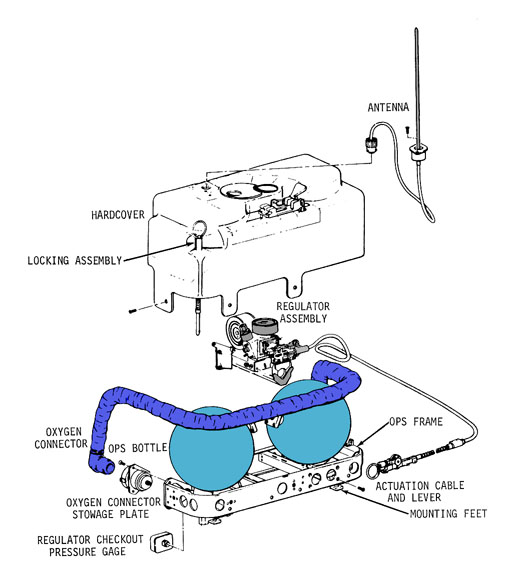
Exploded view of the OPS
081:22:39 Swigert: [Garble].
081:22:41 Lovell: We're damping rates.
081:22:44 Swigert: [Garble].
081:22:47 Lovell: Well, maybe we ought to use the OPS first.
081:25:57 Lovell: You guys moving around? [Pause.]
This is Apollo Control, Houston; 81 hours, 27 minutes now into the flight of Apollo 13. Apollo 13 now 10,776 nautical miles [19,957 km] away from the Moon headed towards the Earth, and traveling at a speed of 4,633 feet per second [1,412 m/s]. To repeat our earlier comments, the master alarm on the CO2 canister was expected to occur at some point in the flight - the return flight. It is normally set for a level of 7.6 mm of CO2 to trigger the alarm.
081:27:25 Brand: Apollo 13, Houston. Over.
081:27:30 Lovell: Go ahead, Vance.
081:27:32 Brand: Jim, just a reminder. Any waste water dumped at this point would really jiggle up the PTC preparation, so request you save that until we're spun up. Over.
081:27:49 Lovell: Right. I don't think we're doing any.
081:27:52 Brand: No. No, I don't, think so, but I just wanted to make sure, you were aware of it - I thought you were.
081:28:03 Lovell: We're saving all the water we can.
The 6.7 level was established to be aware and watch. The medics agreed, however, it would be desirable to raise that number to - for the canisters - to 15 mm CO2 in order to preserve the lifetime on these canisters. And at MSC in the laboratories we have run tests with subjects at levels up to 22 mm of CO2 with no ill effects on the subjects. We're at 1 hour - 81 hours, 29 minutes into the flight and this is Apollo Control, Houston.
081:30:12 Swigert: [Garble] for a minute?
081:30:16 Lovell: With the new space [garble], we're [garble]. We've just about slowed down. You're damping right.
081:31:53 Haise: There she is. [Long pause.]
081:32:34 Haise: And, Houston, Aquarius.
081:32:39 Brand: Houston. Go ahead.
081:32:43 Haise: Okay, Vance. A couple of items we uncovered for that cartridge mod. One is the special dust covering bag that we were going to use on the tote bags, that is pretty thick and nonporous; and we went up to the upstairs kitchen and drained water a couple of more times, and made up a whole bunch of drink bags, again; and from the pantry, we retrieved a fairly large - enclosed - enclosure made of plastic that those drink bags are in that I think we can scissor and also make do for a cover, taping it on, if that's appropriate.
081:33:34 Brand: Okay. Jack Lousma here has a refined version of the procedure on how to make these the easy way, and I think before too long he ought to be reading that up to you. If...
081:33:53 Brand: It's not time critical to get this up to you. It's just that, before you get too far in assembling these on your own, we'd kind of like to give you the benefit of experience down here.
081:34:10 Haise: Okay. Who - Who built them back there.
081:34:17 Brand: Tony did some of it, and Jack's been working on it, too. So we've had a big effort on it.
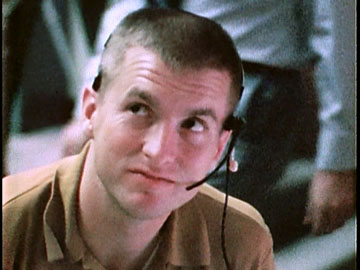
Astronaut Tony England PhD, supporting Apollo 13 in Mission Control. Capture from NASA documentary. NARA.
081:34:27 Haise: Great. [Pause.]
081:34:37 Brand: We would encourage you to wait until tomorrow to receive that procedure, but we can send it up sooner, if you insist. Over.
081:34:47 Haise: No, that's all right, Vance. Before we have to worry about that I guess we got another primary and three secondaries to go through.
081:34:58 Brand: That's right. [Long pause.]
081:35:18 Lovell: You know, sometimes those cartridges have - I guess they rejuvenate.
081:35:29 Brand: Aquarius, Houston. Over.
081:35:32 Haise: Man, that's a wicked low pressure down there.
081:35:38 Lovell: I wish I was on it.
081:35:42 Haise: (Laughter).
081:35:44 Brand: Aquarius, Houston.
081:35:47 Haise: [Garble] up [garble].
081:35:49 Lovell: Go ahead, Houston.
081:35:50 Brand: Okay, Jim. Your rates are once again looking good so we can continue on with the rest of this procedure. Request you go ahead with the Verb 76, Enter, and Mode Control, to Att Hold, and then the last step, 30 clicks yaw right.
081:36:13 Haise: Jets are firing again.
081:36:18 Lovell: Okay. I'll do a Verb 76, Enter with the Mode Control Att Hold and then 30 clicks of right yaw to set the maneuver.
081:36:26 Brand: Verb 76, Enter.
081:36:36 Lovell: There's your Verb 76, Enter. Mode Control to Att Hold. Now you want me to do 30 clicks of right yaw? [Long pause.]
081:36:58 Lovell: Vance, did you say for me to hold on the right yaw or do you want me to start it now?
081:37:04 Brand: No, no need to hesitate, you can start now.
081:37:10 Lovell: Okay. [Pause.]
081:37:20 Brand: After you get that going, then we'll think about powering down the PGNS. [Long pause.]
081:37:39 Lovell: Okay. There were 30 clicks of right yaw.
081:37:43 Brand: Okay. We'd like to look at it for just a little while before we power down the PGNS, so stand by. [Pause.]
081:38:00 Lovell: Understand you're planning to power down the PGNS?
081:38:06 Brand: Right. We want to get the amps down.
081:38:10 Haise: [Garble] finish [garble]. [Pause.]
081:38:19 Lovell: That's bad news.
081:38:20 Lovell: Take 26 pictures of you?
081:38:23 Haise: Why not?
081:38:29 Haise: You want to bring all the film back empty?
081:38:38 Haise: I'd like to just [garble] and shoot it.
081:38:42 Haise: Every last lousy one of them. [Long pause.]
081:39:10 Lovell: Well, that means I've got to...
081:39:14 Lovell: Hey, let me see if I can get this started here.
081:39:18 Haise: Okay. [Long pause.]
081:39:37 Haise: Hey, Jim.
081:39:40 Lovell: Yes, we'll probably get there [garble].
081:41:39 Brand: Aquarius, Houston. Request Aft Omni. [Long pause.]
081:41:54 Haise: You got it, Vance?
081:41:56 Brand: Roger. That did it. Thank you. [Long pause.]
081:42:27 Swigert: Gad, there's Ptolemaeus and Alphonsus.
081:42:30 Haise: Yes, sure enough.
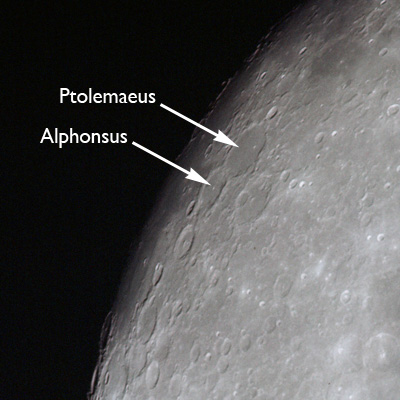
Portion of AS13-60-8701 with Ptolemaeus and Alphonsus indicated, as photographed from Apollo 13.
081:42:32 Swigert: See them right over the edge. [Long pause.]
081:43:11 Swigert: Here, let me shoot a few pictures of the old Moon here.
081:43:15 Lovell: Yes. (cough) Which ones [garble]. Did you put it back ?
081:43:21 Lovell: Looks like we got [garble] to do with Earth? Ptolemaeus?
081:43:24 Haise: We need it to align again. [Long pause.]
081:43:42 Lovell: You don't think that burn was enough, do you? Was that a midcourse?
081:43:43 Haise: The RCS is worse.
081:43:50 Lovell: The RCS [garble] attitude. [Long pause.]
081:44:29 Haise: [Garble] ought to come up the side. Then, you got us in the right plane, Jim. We're in the right plane. We're pointed off and we'll swerve on again with the Earth, Moon, and Sun. [Long pause.]
081:44:52 Lovell: In another respect, it might be easier to get a... [Long pause.]
This is Apollo Control, Houston; at 81 hours, 45 minutes now into the flight. Apollo 13 presently 115 - 11,587 nautical miles [21,459 km] away from the Moon and travelling at a velocity of 4,600 feet per second [1,402 m/s].
081:45:05 Haise: Look in the rear detent now. Go to... [Pause.]
081:45:15 Swigert: How's that?
081:45:19 Haise: Oh, that's right. That blasted service - Command Module is back there. Scratch that one. That one?
081:45:33 Lovell: It's not much better. Okay, let's go this one.
081:45:38 Haise: Keep the [garble].
081:45:41 Brand: Aquarius, Houston. Over.
081:45:46 Lovell: Go ahead.
081:45:47 Brand: Jim, we have some status information for you, if you're ready to copy on a piece of scratch paper.
081:45:58 Haise: Stand by, Vance.
081:46:04 Lovell: We're ready for you.
081:46:06 Haise: Put that away and get some status paper here.
081:46:11 Lovell: Go ahead, Vance.
081:46:13 Brand: Okay. First, midcourse correction will probably be at GET 104 hours, and all we look for is a 4 to 6 feet per second Delta-V. Okay. That's the first item. Now, I will give you a rundown on consumables. Okay. In the LM, you have 1498 - that is 1 4 9 8 amp-hours remaining. That means over 61 hours you'd - That would average out to 24.5 amps. We expect that, after powerdown, that you will use 1 4 or 14 amps per hour, and that would leave a reserve of 500 amp-hours at the end of the mission. Are you with me?

Estimated water, oxygen, battery power and LiOH supplies left at this moment. From the TELMU report.
081:47:29 Lovell: Roger. We're with you.
081:47:30 Haise: I saved my - number was yesterday.
081:47:33 Brand: Okay. In the LM, you have...
081:47:36 Lovell: We're with you.
081:47:37 Brand: Roger. In the LM, you have 215, that is 2 1 5, pounds of water, usable. That would average out over 61 hours to 3.5 pounds per hour available. Okay. [Pause.]
081:48:15 Brand: Okay. And after you power down, we expect that you will be using water at the rate of 3.2 to 2.7 pounds - That's at 14 amps per hour electrical usage rate. One note, this does not - When we speak here of water available, this does not include CSM water and PLSS water, so that's added on. Okay, next, LiOH. Using the CSM cans, you will have 16 cans at 12 hours per can to give you 1 9 2, or 192 hours, of LiOH. And, in the LM, using its cans, you have 44 hours remaining. [Pause.]
081:49:29 Lovell: Vance, is that with the PLSS secondaries?
081:49:34 Brand: That's affirm. That's affirm. That includes PLSS secondaries. [Pause.]
081:49:47 Brand: Okay; oxygen. You have remaining 44 pounds in the LM. At a usage rate of 0.36 pounds per hour, that leaves you 120, or 1 2 0, hours of oxygen. Okay. Next, RCS. RCS A stands at 6 2 percent and B at 6 2 percent. We only expect 2 percent to be used for the PTC, so you're in good shape for RCS. Next, DPS Delta-V. You have 1190 feet per second remaining. And, finally, CSM EPS. We estimate that you have 99 amp-hours. That's an estimate. And that's it. Over.
081:51:19 Lovell: Okay. I copy.
081:51:24 Brand: Okay. And just a question. It would be interesting to hear from Jack to see if he thinks that Main B bus is good. If he has any idea of how, if whether it's good or not, this would influence our steps in the future; for example, we might want to try to test Main B to see if it is, in fact, good so that we'd know how to set switches for entry.
081:52:00 Lovell: Roger. Just a minute. They want to know whether you think Main Bus B is any good for the Command Module. [Pause.]
081:52:14 Lovell: Vance, while Jack's got on the loop, let me pose the question of how we're planning on doing this midcourse, if we are going to power down the PGNS.
081:52:27 Brand: Would you stand by on that, Jim? We'd like to give you a procedure for that later on.
081:52:34 Lovell: Okay. Got a midcourse at 104 hours, He's going to give us a procedure for that later on.
081:52:48 Brand: In short, Jim, we don't expect any problem, but we'll explain further later on.
081:53:02 Brand: Deke says get a night's sleep. He says you've been working hard, and you ought to relax a little bit and be ready for tomorrow.
081:53:17 Swigert: Vance, this is Jack.
081:53:19 Brand: Go ahead, Jack.
081:53:23 Swigert: Okay. Let me give you my observations on Main Bus B. Things happened pretty fast there, and we first heard the impact or explosion or whatever caused it, I'm not sure. The next - About 1 second later, there was a Master Alarm which was the Main Bus B Undervolt. I looked at the voltage, and the voltage was good at this time so I'm suspecting it was a spike. Fuel cell 3 was also good, with good flow. However, Fred, at that point, was coming into the Command Module and got over into his seat. At that time, we shortly had an AC Bus 2 light about the time he got into his seat. He looked at the Main Bus B and the Main Bus B was reading zero. It, however, - and the fuel cell flows were zero. I'm kind of suspecting that perhaps we do have a Main - a current Main Bus B. But that's merely a guess. I never did try to reset it. We were having other problems with the Main Bus A, having an Undervolt and a few other things like that. I'd kind of like to hear what your feelings are down there.
081:54:55 Brand: Well, Jack, we copy your information. And we'd like to hold off because we're still working the problem. So we'll have to give you information later. [Pause.]
081:55:14 Brand: Thank you.
081:55:23 Brand: Aquarius, request Aft Omni. [Pause.]
081:55:37 Swigert: Vance, are you back with me?
081:55:40 Brand: Roger. We're with you.
081:55:44 Swigert: Okay. We lost lock there. We switched Omnis. Just for my own - kind of to get my thoughts in order, I'd kind of hear what - I'd like to hear what kind of entry you're planning. EMS or PGNCS or what?
081:56:02 Brand: Okay. PGNCS entry is being planned, and people are at work on checklist changes and that sort of thing.
081:56:14 Swigert: Okay. Real fine.
081:56:17 Brand: And - we'll - We'll give you the CSM stuff tomorrow, but basically we expect that Main Bus B is good and we're going to work up a procedure to test it.
081:56:32 Swigert: Okay. Those are my thoughts, too.
081:56:34 Brand: Roger...
081:56:36 Swigert: You think Main Bus B is good, don't you?
081:56:39 Brand: That's affirm. We think it is, but we want to check it out anyway.
081:56:42 Slayton: We think you guys are in great shape, all the way around. Why don't you quit worrying and go to sleep.
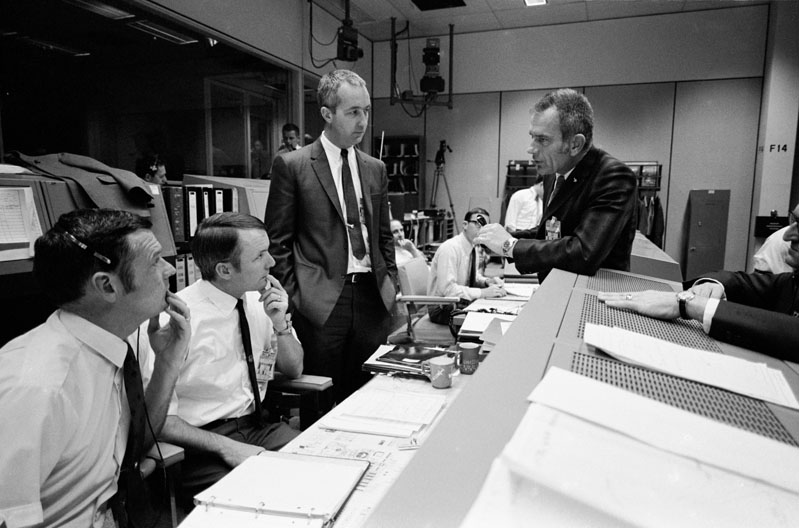
Photo S70-35369 - Mission Control during the Apollo 13 crisis. Seated are Flight Directors Glynn Lunney and Gerald Griffin. Standing up in a suit is Apollo 9 astronaut and then Apollo program manager Jim McDivitt. Deke Slayton on the right, looking at the other men.
081:56:46 Swigert: Okay, Vance.
081:56:51 Swigert: Oh, that - That's our boss, Deke.
081:56:58 Lovell: Well, I think we just might do that - or part of us will. [Long pause.]
081:57:25 Swigert: I mixed up. How many more of those - Are we hot mike?
081:57:28 Lovell: Yes. [Pause.]
081:57:36 Swigert: Yes, I'm mixed up. You had 15? I mixed up seven more. So we got 22. By the way, there's still some water that's - it's not enough pressure to mix up another drink, but there is some water out of there, if you want to get some water out of the drink cup.
081:57:59 Lovell: That's good; I could use some.
081:58:00 Swigert: We ought to use that oxygen up and not waste it. (Cough) [Long pause.]
081:58:17 Lovell: You monitoring right now?
081:58:23 Swigert: Yes. Just stand by.
081:58:25 Haise: What'll it take to [garble].
081:58:30 Haise: You only got two [garble] there, so [garble].
081:58:34 Swigert: I will. [Long pause.]
081:58:49 Swigert: You wouldn't believe it, but I'm now in command of the LM. Okay. Vance, I'm probably the only CMP that's ever witnessed a DPS burn sitting on the ascent engine head. [Long pause.]
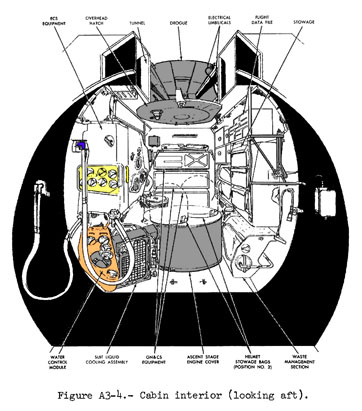
LM cabin, looking aft.
081:59:33 Haise: Did you get some? Is there any coming out still? They didn't answer. I think we made it. How's this working out?
081:59:52 Lovell: Okay. No problem.
081:59:55 Swigert: They are, huh? How are we going to get an alignment?
082:00:03 Lovell: We'll pull one out some ways, I guess. We've gotta watch that one right there.
082:00:18 Haise: It's decreasing now. It'll - it'll - It's cold. I noticed that in the Command Module. It'll wobble. [Long pause.]
082:00:51 Lovell: Houston, Aquarius. [Pause.]
082:00:59 Lovell: Switch Omnis to Transmit.
082:01:02 Lovell: Houston, Aquarius.
082:01:04 Lousma: Go ahead, Aquarius.
082:01:08 Lovell: Roger. Are you planned to set up here very shortly - a powerdown procedure?
082:01:15 Lousma: That's affirmative, if you'll take out your contingency book and turn to page Power 6. Over.
082:01:23 Lovell: Roger. Stand by. Contingency Power 6. Get the book over here. Contingency Power 6.
082:01:33 Haise: Well, I hope this [garble].
082:01:37 Lousma: And while you're doing that, let's put Attitude Control, three, switches to Mode Control. [Pause.]
082:01:50 Lovell: All three Attitude Control switches have been in Mode Control.
082:01:53 Lousma: Okay. And when you get to Power 6, you ought to see a circuit breaker page, panel 11.
082:02:03 Lovell: Have a pencil? Let's see it - thank you. [Pause.]
082:02:12 Lovell: Okay. I have Power 6, panel 11.
082:02:17 Lousma: Okay. On Power 6, panel 11 - The top three rows, configure them as you see them.
082:02:31 Lovell: Okay, now, Jack [garble] We have put the TCAs in for the previous procedure. Do you want those out, now?
082:02:48 Lousma: That's affirmative. Jim, Pull them out. TCAs open.
082:02:54 Lovell: Okay. I'm changing those to - back again. First three rows. And you're pulling the ATCA PGNS, huh.
082:03:04 Lousma: That's affirmative. Pull ATCA PGNS open.
082:03:11 Lovell: Okay. I've done that.
082:03:20 Lousma: Okay. Are you ready for the fourth row?
082:03:25 Lovell: Affirm.
082:03:27 Lousma: Okay. Now when we get in the fourth row, we're going to open the IMU OPERATE circuit breaker; and what that means is that we're going to lose the capability to watch your CDUs, so we're not going to be able to see your attitude. Therefore, we will not be able to advise you on which antenna to select for communications. The way we want you to handle that is to turn the LM Uplink Squelch off, and when you hear the noise, switch antennas. We'll be able to see you switch antennas, and it's going to take us about 3 to 5 minutes to establish a lockon again after you switch. After each time that you switch antennas, we will initiate a voice check. And basically when you see the Earth out the window, you can be on Forward antenna, and when the Moon's up in the window use the Aft antenna. You copy? [Pause.]
That's Jack Lousma on the capsule communicator position.
082:04:41 Lovell: Okay. We're going to pull the IMU OPERATE circuit breaker, so you won't be able to see our attitude. Therefore, you won't tell us how to switch antennas and we'll enable the - I will turn the - up the Squelch Off so that when we start getting any static, we'll switch antennas and as a thumb rule we could use - with the Earth forward, we use the Forward antenna and when we see the Moon we use the Aft antenna.
082:05:12 Lousma: That's affirmative, Jim. In other words, we're leaving the antenna switching up to you, and after you switch antennas it's going to take 3 to 5 minutes for us to establish a lockon again, and we'll initiate a voice check. And I'm ready to go on panel 11, row 4.
082:05:36 Lousma: Okay. On row 4, under Heaters RCS System A/B-1: open Quad 1 through 4; under ECS, the only change is - under Glycol Pump, close Auto Transfer; under Comm, the only change is: open VHF A Receiver, open Commander Audio; under PGNS, the only change is: close and leave closed IMU Standby circuit breaker, so we can have heaters. Read back. [Pause.]
082:06:30 Lovell: Okay. On row 4, we're going to open all four off the heaters - the RCS System A and B - the first four circuit breakers. We're going to close the Auto Transfer. We're going to open the VHF A Receiver and the Commander Audio. And we're going to close the IMU Standby. The LGC DSKY and the IMU Operate will be open.
082:07:05 Lousma: That's affirmative, Jim. All other breakers in that row are as you see them in the checklist. And on row 5, the only change is that we want you to, under EPS, open Ascent ECA Control. Over. [Pause.]
082:07:25 Lovell: Roger. I think we already have that opened - Ascent ECA Control is probably already open. [Pause.]
082:07:36 Lovell: Okay. So let me confirm. We'll have one Comm system, that will be the LMP system, and we'll have to do our own antenna switching; therefore, we'll have to wait about - Okay, why don't you switch? Aft antenna.
082:08:04 Lovell: We'll have to wait for you to get a lockon again. Is that correct?
082:08:14 Lousma: That's affirmative, Jim. You'll be working off of the LMP's panel over there.
082:08:22 Lovell: Okay. What else do you have for me?
082:08:24 Lousma: Okay. Panel 16, that's on page Power-7. Top row, the only change is: under RCS System B, open PQGS/Displays. Over. [Pause.]
082:08:50 Lovell: Okay. I may go over this with you, Jack, because this checklist has been written over two or three times now on our various procedures. Top row, the first two are open, the next three are closed, and we're going to open now the Quad TCA's 1, 2, 3, 4; Crossfeed will be closed, and the Temp/Press Displayflag will be opened, and we're going to open up the PQGS, Main SOV will be closed, and the [garble] will be opened.
082:09:26 Lousma: That's affirmative, Jim. And there's no change to the second row. Over. [Pause.]
082:09:38 Lovell: Okay. Again, let me go through this with you. The first four are going to be closed. The next sev - eight will be - the next nine will be open from Logic Power B through Descent Engine Override. How about the CWEA? Is that going to be closed?
082:10:08 Lousma: That's affirmative, Jim. We want the next five closed.
082:10:16 Lousma: Okay. In the third row, under Comm: Display, Open; SE Audio, Closed; VHF A Transmitter, Open - That's a change - VHF B Receiver, Open; Primary S-Band, Power Amplifier, Open; Transmitter/Receiver, Closed; S-Band Antenna, Open; PMP, Closed; TV, Open. Under ECS: Displays, Open; Glycol Pump Secondary, Open; LGC Pump, Open; Cabin Fan Control, Open; Cabin Repress, Closed; and all the next four, Closed also. Read back.
082:11:12 Lovell: Okay. We have Display, Open; SE Audio, Closed; VHF A Transmitter, Open; VHF B Receiver, Open; Power Amp's going to be Open; Transmitter/Receiver, Closed; S-Band Antenna, Open; PMP, Closed; TV, Open; Display is Open; next three are Open; Cabin Repress, Closed; and all the rest, Closed.
082:11:36 Lousma: That's affirmative, Jim. And in row 4, under Heaters, we want them all - Correction - we want all the Quad Heaters, Open. Correction - we want all the Quad Heaters, Closed.
082:11:53 Lovell: All the...
082:11:54 Lousma: We want Display, Open; S-Band Antenna, Closed - to avoid a Master Alarm, Camera - Sequence Camera, Open; And under EPS, we want Displays, Open; DC Bus Volt, Closed; Inverter 2, Open; Ascent ECA, Closed; Ascent ECA Control, Open; Descent ECA, Closed; Descent ECA Control, Closed; Translunar Bus Tie, Close; we want the Cross Tie Bus, Open; the Bal Loads, Closed; Bat Feed Ties, Closed. How do you read?
082:12:46 Lovell: Okay. The four RCS Heaters will be Closed; Displays, Open; S-Band Antenna, Closed; Camera Sequence will be Open; Display will be Open; DC Bus Volt will be Closed; Inverter 2, Open; Ascent ECA will be Closed, but the Ascent ECA Control, Open; Descent ECA, Closed; Descent ECA Control, Closed; Translunar Bus Tie, Closed; and Cross Tie Bus, Open; and Balance Loads, Closed; and the Bat Feed Ties, Closed. I have one question, Jack. On panel - on the second line there under Lighting, why are we keeping: the Floods and Track closed? Or are they going to be open?
082:13:33 Lousma: Negative. We have the, Lighting breakers all closed. Control the lighting with the switches and rheostats. Over.
082:13:44 Lovell: Okay. We don't need the floodlights, I don't think, but we can do it that way, I guess.
082:13:51 Lousma: And under row 4, under RCS Systems A/B-2, Quad Heaters, you notice that we've closed those circuit breakers, but what we want you to do is to - on panel 3, turn the RCS A/B-2 Quad switches 1, 2, 3, and 4, off. Over. [Pause.]
082:14:28 Lousma: And we're going to watch your quad temps for you, and when we need to warm them up a little bit, we'll tell you to throw those four switches on - on panel 3.
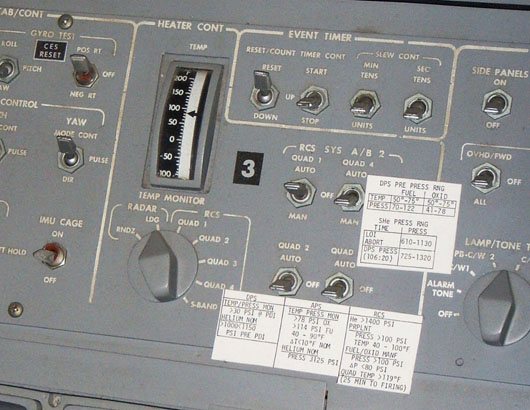
Panel 3 RCS heater switches as seen in a LM simulator. They plan to control the RCS temperature manually as required. Image courtesy of Frank O'Brien.
082:14:43 Lovell: Okay. Now are we sure that this PTC mode is good enough so we don't [garble] get crossed up later and get out of configuration.
082:14:53 Lousma: Stand by 1 on that, Jim. Okay, Jim, as far as we can tell right now, the PTC looks as good as any PTC we've ever seen in a CSM, so we're going to go with what we've got.
082:15:18 Lousma: Okay, and if you turn over the page on Power 8, we have the spacecraft functions remaining to you. We've got low bit rate TM. However, we don't have any VHF. We have CWEA. We have Glycol Pumps. We have Suit Fans. We have Cabin Repress for you, and stand by in Attitude Control here. Okay, in Attitude Control, we'll have hardovers for uses in emergency, and for normal usage we want to have a 15-minute delay to get the heaters on to warm them up before use. How do you read?
082:16:06 Lovell: Okay. For emergency, we have the hardovers and for normal use it requires a 15-minute request to get the heaters on.
082:16:16 Lousma: That's affirmative. [Pause.]
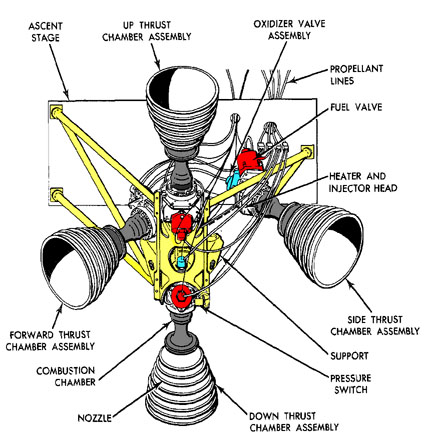
A LM Thrust Chamber Assembly.
082:16:28 Lousma: Okay, Jim, that concludes our powerdown procedure, and we're waiting for you to get with it
082:16:37 Lovell: Okay, Jack, we'll start. I sure hate to lose the PGNS. I sure hope that procedure for the midcourse is a good one.
082:16:45 Lousma: It is. [Pause.]
082:16:55 Swigert: You want me to help you here?
082:16:57 Lovell: Yes, you can - Okay. First we power down panel 11. All of them open. [Pause.]
082:17:15 Lovell: Closed. [Pause.]
082:17:24 Swigert: Yes. [Long pause.]
082:17:56 Lovell: Stand by for a Master Alarm. [garble]
082:17:57 Swigert: Okay. [Long pause.]
082:18:12 Lovell: Here it comes. [Long pause.]
082:18:54 Swigert: LTG. You just did it. [Long pause.]
082:19:18 Lovell: I'll give you this when I'm finished. After we go through this, then you can go through it again and double check it.
082:19:23 Swigert: Right. [Long pause.]
082:20:07 Swigert: Now, the flood lights are on, right? No, I kind of don't think we need them though, do you?
082:20:15 Lovell: Don't pull those. Give me the - first of all. We'll get back there. Those four are Close, Open, Open, Engine Arm, Open, [garble]
082:22:36 Lovell: Say, Houston; Aquarius.
082:22:38 Lousma: Go ahead, Aquarius.
082:22:40 Swigert: It will take him a minute to [garble].
082:22:43 Lovell: You're familiar with our particular spacecraft that on panel 16 Heaters RCS Systems A and B, Quad 1 Heater circuit breaker has been pushed in, and sealed in, and if it's ever pushed out, it's doubtful if we'll ever be able to reset it. [Pause.]
082:23:06 Lousma: Okay, Jim, on the four Quad Heater breakers, we want you to leave them closed. And we'll operate the heaters with the switches on panel 3. Over.
082:23:19 Lovell: Okay. [Pause.]
082:23:27 Swigert: No. [Long pause.]
082:24:07 Lovell: Okay. We'll do it right there.
082:24:11 Lovell: Okay. And I'm closing the Heaters on panel 4, Quad 1 through 4, Off.
082:24:23 Lousma: Okay. It's time for you guys to get to bed and get Fred up.
082:24:33 Lovell: (Laughter) I still have one question, Jack. I still think that - I still say that the - on the Lighting in our panel 16, the Flood lights and the Track should be open. We're not using them.
082:24:48 Flight director: Do you have any argument about...
082:24:53 Lousma: No problem, Jim. Go ahead and open them, Track and Flood, that's all right.
082:25:03 Swigert: Okay, Track and Flood are Open.
082:25:07 Lovell: Now, why don't you go through that, Jack, and make sure those...
082:25:12 Lovell: ...[garble].
082:25:15 Swigert: Okay, I'll take this.
082:25:16 Lovell: Okay, Jack, my only other concern now is the CO
2 rise in the spacecraft. I guess you're keeping a handle on that?
082:25:26 Lousma: That's affirmed, Jim. We have up to 10.6 now, and we're willing to go a little higher on that. We have another cartridge and we have a procedure for making the Command Module cartridges up. We'll pass that on later.
082:25:42 Lovell: Oh, yes. I'm not worried about that. I just wanted to make sure that you...
082:25:46 Swigert: Are they going to...
082:25:47 Lovell: ...that - We just don't want to go to sleep here and forget about the rise in CO
2.
082:25:51 Swigert: Are they going to use [garble]...
082:25:52 Lousma: Roger. We're watching it for you...
082:25:54 Lovell: Yes, they're getting it [garble].
082:25:55 Lousma: - We have it here. It's now 10.7 and we have a medical Go to 15 millimeters.
082:26:03 Swigert: That's a new one.
082:26:04 Lovell: There's a new first for you. [Long pause.]
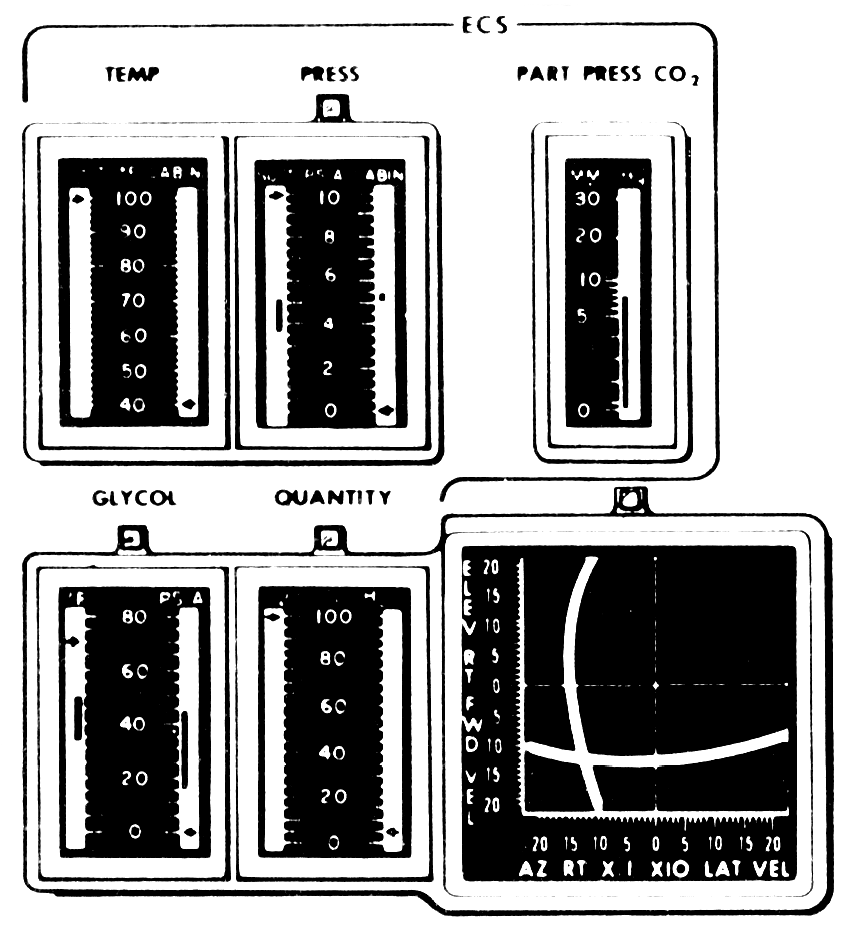
ECS displays at the System Engineer's (LMP's) console at the LM cabin. Scan via heroicrelics.org
082:26:19 Lousma: Okay, Jim, we estimate we've got 1 more hour on the primary cartridge, and 6 or 7 hours on the secondary.
082:26:31 Lovell: Okay. Fine. Say, it's a spare primary cartridge back there, too, isn't it? So that's good for another, how long? [Long pause.]
082:27:10 Swigert: Yes. Yes. That's yours though, isn't it?
082:27:14 Lousma: And you're right, Jim. We've got another primary cartridge back there behind the ascent engine cover.
082:27:21 Lovell: Right, yes. We know. Thank you. [Long pause.]
082:27:43 Swigert: Yes, yes, I just - [Pause.]
082:27:51 Swigert: Okay. I guess you've done everything right on that panel. Let me check the middle one. Yes. You powered down and then you leave me. Tell me, I've got it.
082:28:05 Lousma: Okay, Jack, we just thought it's about time you got a LM checkout. [Pause.]
082:28:16 Swigert: But he's giving it to me inert. Of course, I'm giving him my Command Module, too, which is rather inert right now, too. [Pause.]
082:28:32 Lousma: Well, you've got to walk before you run, you know.



